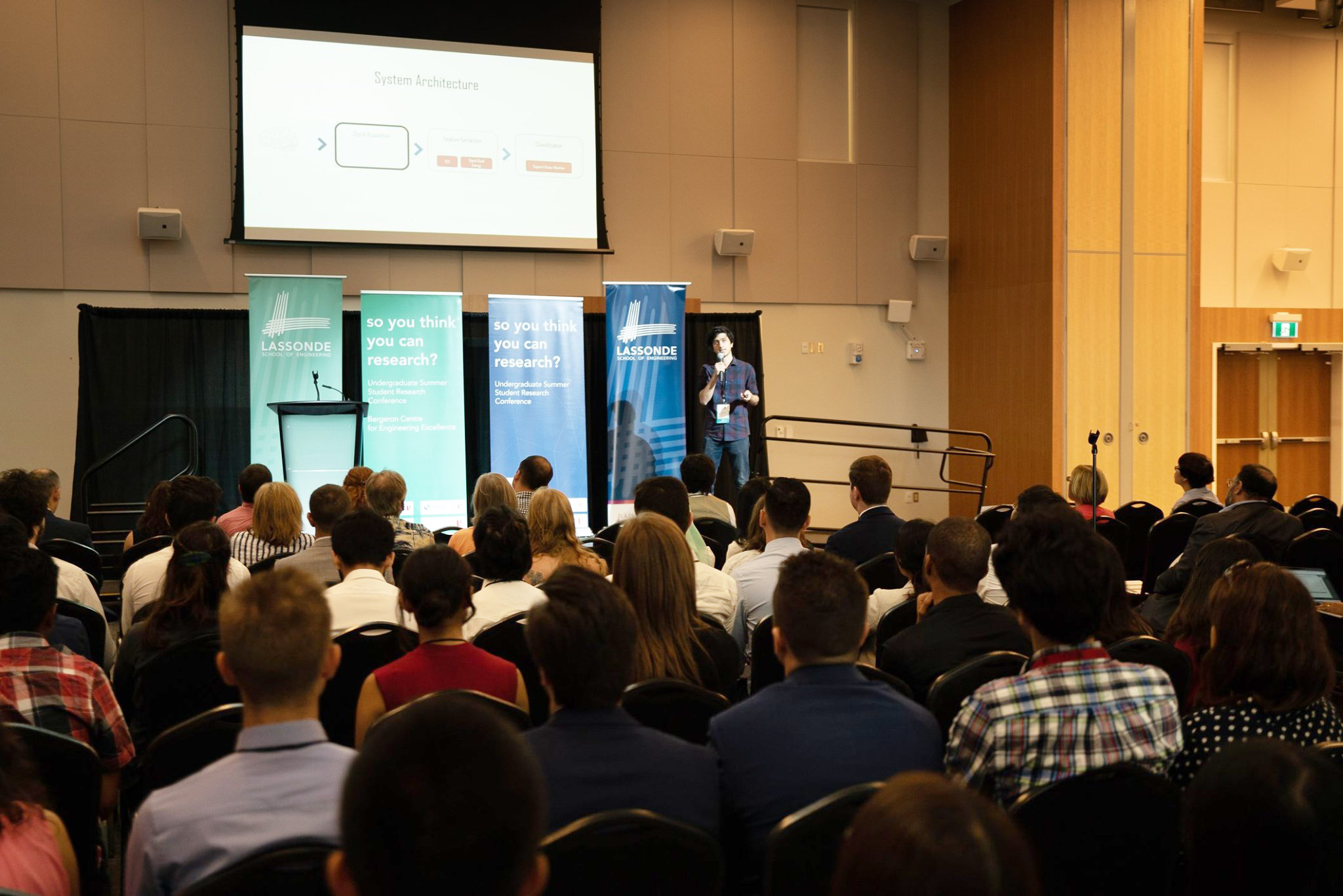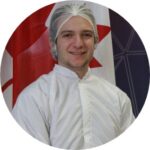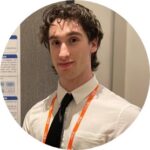
Lassonde Undergraduate Summer Research Conference 2023 Researchers
Get to know your researchers!
Project Presentations
This year’s research conference includes project presentations of undergraduate students and their research experiences. Read firsthand as these students share their experiences and discuss the various research opportunities available to undergraduates. Explore a variety of topics and subject matter at this year’s conference. Learn about recent discoveries, cutting-edge research, and emerging technologies in fields such as Indigenous settlements and fire safety, Sensitivity analysis of orbit accuracy relative to the attitude pointing/knowledge accuracy, Development of wearable microfluidic patches Integrated with Organic Electrochemical Transistor (OECT) sensors for the detection of inflammatory biomarkers in sweat, Development of an autonomous mobile 3D bioprinting system for regenerative medicine and more.
Researchers
-
Civil Engineering

Abdul Nasir
Program: LURA
Supervisor: Rashid Bashir
Profile: Civil Engineering graduate, has been working on how Climate Change is affecting our civil infrastructure for three years. participating in research is an opportunity to explore my passion and to challenge myself with hands-on experience in conducting experimental labs and generating experimental models.
Abstract Title: Effect of Climatic Conditions on the Development of Thermal Loads
Abstract Authors: Abdul Nasir, Saad Saad, Rashid Bashir*
Abstract: Thermal loads have a significant influence on the structural stability of bridge decks. The thermal stresses acting on a bridge are governed by environmental factors such as temperature, wind speed, cloud cover, and solar radiation. Design codes typically estimate these climate variables based on historical climate data. However, due to the effects of climate change, these estimates are likely to change with the return period for design events decreasing i.e., a higher frequency of exposure to extreme events. The aim of this study is to investigate the effect of climate change on the thermal load acting on a bridge by comparing the historical thermal load acting on a structure and the future projected thermal loads. This is achieved using a three-dimensional finite element thermal model of a box girder bridge. Observed historical climate data (representative of extreme conditions for two different locations) are applied as boundary conditions in the model. The maximum temperature differential within the cross section is then determined. A similar analysis for each location is then performed using future climate data projected from a weather generator for several selected global climate models. The obtained temperature differentials from both sets of simulations are then analyzed and compared. The obtained results indicate that climate change will have a significant effect on future thermal loads which must be taken into consideration in future bridge design codes to ensure a safer and more efficient design process. KEYWORDS: Climate Change, Thermal Load, Statistical Study, Box Girder, Finite Element Modeling, Climate Models, Climate data generator.
Ammar Mahgoub
Program: USRA
Supervisor: Stephanie Gora
Profile: Ammar is a graduate of the civil engineering program at York University with interests in water and wastewater engineering. He is drawn to this area of research because of his passion for water treatment and desire to contribute to finding innovative solutions to assist this process. This interest was developed during his time as an undergraduate student when he was working part-time as a research assistant with Dr. Stephanie Gora on a project about drinking water safety in small communities in Canada and when he was taking courses that were related to water and wastewater treatment.
Abstract Title: Expansion of a Pilot Plant at Ajax Treatment Plant
Abstract Authors: Ammar Mahgoub, Stephanie Gora*
Abstract: The drinking water treatment industry is constantly evolving with new and emerging technologies being integrated into the water treatment process. A pilot plant can be used to assist in the testing and simulation of a new system or technology on a smaller scale. The results can then be used for the design of full-scale plants. The Ajax Water Treatment Plant (WTP) draws water from Lake Ontario and treats it through direct filtration, chlorine disinfection and fluoridation. Currently, Durham Region is looking to rejuvenate the pilot plant on-site at the Ajax WTP. The goal of this project was to work with Durham Region operational staff to assess the existing pilot plant to ensure that it replicates the design, operation, and performance of the full-scale plant. This was achieved by working with plant operators to learn about the process and reviewing existing documents to determine how well the instrumentation and processes were working. Furthermore, schematics of both plants were created to determine the similarities/differences, including the physical and chemical processes for water treatment. After comparing the pilot plant to the full-scale plant, a modification plan has been suggested for the pilot plant, which is based on the functionality of the technology and physical/chemical processes in the pilot. For example, the implementation of modern technologies was proposed through wireless and Bluetooth software because it simplifies the operation and maintenance of the pilot plant. Furthermore, a budget breakdown of all the suggested vendors and total cost information for the proposed modifications has been provided to the Durham Region as well. The suggested modification plan is vital for the expansion of this pilot plant and will also assist in any testing of new technologies for water treatment on a smaller scale, minimizing water safety risks in the Ajax WTP in the future.
Emma Bresil
Program: USRA
Supervisor: John Gales
Profile: Emma is in her third year of Civil Engineering where she is exploring her passions of Structural Engineering and Fire Safety Engineering. She has a strong connection with nature and is highly motivated by sustainability. She is interested in the application of research in industry, specifically in making industry practices more sustainable. In continuing research with Dr. John Gales, she is looking to further the development of sustainable materials and their use in structures, with a focus on the fire testing of building assemblies.
Giovanni Paolo De Lio
Program: RAY
Supervisor: Kamelia Atefi Monafared
Profile: Giovanni, since his childhood, has always been interested in why mechanisms in our world work the way they do. In the pursuit of this knowledge, Giovanni found himself at York University’s Lassonde School of Engineering. In his second year of studies, he was offered a position to begin researching geothermal energy structures. With his lifelong journey to a greater understanding of his world, he willfully accepted the offer from Dr. Kamelia Atefi Monfared. Now Giovanni is partaking in the pleasure of working alongside her, and other teammates in the study of energy structures and their viability in today's world.
Abstract Title: Geothermal Active Energy Structure Research
Abstract Authors: Giovanni Paolo De Lio, Kamelia Atefi-Monfared*
Abstract: Geothermal heating and cooling systems utilize the constant temperatures deep into the ground, to provide an eco-friendly and efficient source of energy as an active means to control climate change. These systems have been proven effective in numerous locations all over the world. However, some key limitations of such systems include the need for space, supplementary construction, and high capital. Geothermal energy structures, such as energy foundations or energy tunnels, utilize components of the existing structural system that are in contact with the surrounding soil as heat exchangers. My research aims to explore the fundamental thermo-mechanical processes governing the efficiency of energy structures under various in-situ conditions. I will utilize the FLAC3D software from Itasca to conduct advanced coupled geo-mechanical modeling. The model developed during my research will allow for a comprehensive investigation of the impact of various parameters on the efficiency of energy structures. Ultimately, we will use the obtained knowledge to facilitate the prescription of design codes and standards, incorporating the thermo-mechanical aspect of energy structures to ensure the efficacy and safety of such structures during their service lifetime. The absence of codes pertaining to this technology is the largest barrier to its use, which prevents its influence in achieving many of the UN's sustainable development goals. In particular, energy structures aim to play a large role in the accomplishment of goal 7 "Affordable and Clean Energy" and goal 11 "Sustainable Cities and Communities". By offsetting costs and diminishing spatial requirements, this technology promises to make geothermal heating systems a popular avenue to lower cost, clean energy worldwide.
Giuseppina Alfarano
Program: LURA
Supervisor: John Gales
Profile: I am Giuseppina Alfarano I m a third-year Civil Engineering student at Lassonde. I choose to participate in research because I am really into timber and would love to learn more about it.
Ishleen Passi
Program: USRA
Supervisor: Liam Butler
Profile: Ishleen Passi is entering her last year of Civil Engineering. She chose to participate in this research program because she wanted to gain experience working in the research area of engineering. She also wanted to understand how various climatic conditions can impact infrastructure materials and their properties. Researching environmentally sustainable materials is also very interesting as they can potentially be used in the construction of new infrastructure while also helping the environment. Lastly, Ishleen enjoys conducting lab experiments and gaining new knowledge about various engineering topics.
Abstract Title: Evaluating the Effect of Climate on the Mechanical Properties of Low-Carbon Concrete
Abstract Authors: Ishleen Passi, Peace Ikpotokin, Liam Butler*
Abstract: The implementation of sustainable construction practices is important in reducing the harmful effects of climate change on the environment. The production of concrete is responsible for a significant portion of annual carbon dioxide emissions. Hence, alternative forms of low-carbon concrete must be developed to reduce the overall carbon footprint of the construction sectors. The purpose of this research project was to analyze the impact of various climate factors (e.g., temperature and humidity) on the compressive strength and elastic modulus of low-carbon concrete produced using recycled and secondary materials. To study this effect, several batches of low-carbon concrete consisting of various proportions of natural coarse and fine aggregates, coarse and fine recycled concrete aggregates, and ground granulated blast furnace slag were produced. All mixtures were designed to achieve a target compressive strength of 30 MPa such that they would be suitable for use in most structural applications. A total of 96-cylinder specimens were cast. Half of the specimens were placed indoors under controlled climate conditions and the remaining were placed outdoors. All specimens were cured (either indoors or outdoors) for a minimum of 28 days. Both temperature and relative humidity were recorded for both indoor and outdoor environments using thermometers and hygrometers. The compressive strength and elastic moduli testing are currently in progress. Understanding how low-carbon concretes perform under ‘real’ outdoor conditions is a critical step in promoting their adoption in the construction of sustainable structures for communities around the world. This research directly aligns with the ‘U.N. Sustainable Development Goal #11 Sustainable Cities and Communities’, which is associated with reducing the carbon footprint of concrete thereby mitigating the effects of climate change on the environment.
Jaiden Fairclough
Program: RAY
Supervisor: Kamelia Atefi-Monfared
Abstract Title: Thermo-Mechanical Efficiency of Energy Piles
Abstract Authors: Jaiden Fairclough, Kamelia Atefi Monfared*
Abstract: Geothermal energy piles are dual structural elements that provide load bearing and can be used to provide space heating or cooling energy using sustainable geothermal energy. Energy pile foundations contain pipes, normally made of high-density polyethylene. These pipes carry a working fluid, typically water, that acts as a heat exchanger to heat up or cool down the pipe which in turn can provide heating or cooling for a given super-structure. The key aspect that ensures an efficient design is optimization of the thermo-mechanical performance of the energy pile. In this project, I evaluate the use and efficiency of energy piles in the Canadian environment and ground conditions using advanced numerical modelling conducted with COMSOL Multiphysics. I develop new coupled numerical models to evaluate the governing thermo-hydraulic-mechanical (THM) processes involved in these energy structures under various pile configurations and in-situ conditions. The ultimate goal is to evaluate the applicability and efficiency of this technology for the Canadian Climate. The implementation of energy piles would address the UN sustainability goals of Affordable and Clean Energy, Sustainable Cities and Communities, and Climate Action.
Kiara Mavawala
Program: USRA
Supervisor: John Gales
Profile: Kiara Mavalwala is going into her third year of civil engineering where she is building the strong foundation required to help resolve injustices through sustainable solutions across Turtle Island and beyond. Mother Earth plays a significant role in her life, fuelling her responsibility to protect the Earth and empower the traditional stewards. After taking an intriguing class with Dr. John Gales, Kiara was inspired by his passion for EDI and experiential approach to engineering education.
Nikta Afzali
Program: LURA
Supervisor: Satinder Kaur Brar
Profile: Nikta is a bachelor’s student that has been highly interested in sciences and research. Currently, she is involved in a research that includes the recovery, handling, and preservation of a microbial culture collection as well as on the isolation of several microbes from different environmental sources. She chooses to participate in this research to improve her knowledge about microbiology, to refine her laboratory skills and to develop research Standard Operating Procedures in microbiology.
Abstract Title: Discovering A Carotenoid Biofactory Called Rhodosporidium toruloides
Abstract Authors: Nikta Afzali, Carlos S. Osorio-Gonzalez, Satinder Brar*
Abstract: Carotenoids, lipophilic pigments synthesized by plants, are widely recognized for their robust antioxidant properties. Apart from their antioxidant capacity, carotenoids offer numerous health benefits, notably their ability to stimulate provitamin A and vitamin A synthesis. However, these compounds are predominantly sourced from food, such as fruits and vegetables, which face limitations due to seasonal availability and susceptibility to environmental factors. In recent years, there has been a surge in research focusing on the production of carotenoids through microbial-based approaches. Various microorganisms, including fungi, bacteria, algae, and even aphids, have been explored for their potential in carotenoid synthesis. Among them, the red yeast _Rhodosporidium toruloides _has_ _emerged as a prominent candidate, revered for its remarkable capability to produce an array of carotenoids, encompassing α-carotene, β-carotene, torulene, torularhodin, and many others. The primary objective of this study is to delve into the production of carotenoids utilizing the red yeast _Rhodosporidium toruloides._ Extensive investigations were conducted on five distinct strains of _Rhodosporidium toruloides_ to discern their individual capacities in carotenoid production. Additionally, the influence of light exposure during the production process was meticulously evaluated to ascertain its impact on carotenoid synthesis. In line with sustainable practices, this study explores the potential of utilizing agro-industrial residues as substrates for biotechnological carotenoid production by microorganisms. This approach holds promise as it not only reduces waste but also provides a cost-effective and environmentally friendly alternative for carotenoid synthesis. Furthermore, the implications of microbial-based carotenoid production extend far beyond the laboratory. A broad spectrum of industries and products, including aquafarming, food supplements, cosmetics, cattle feed, and pharmaceuticals, stands to benefit from the vibrant hues and health-promoting properties of these natural pigments. The market potential for such products is substantial, as consumers increasingly seek natural and sustainable alternatives in their choices.
Shahrzad Rahmani
Program: LURA
Supervisor: Satinder Kaur Brar
Profile: Shahrzad is an enthusiastic Biology undergraduate student who possesses a strong passion for understanding the intricate workings of living organisms and their impact on the environment. Her academic journey and hands-on experiences in the field of biology have fostered a deep appreciation for the intricate complexities of nature and the need to protect and restore it. By participating in this research, she sees an opportunity to apply their knowledge and skills to contribute to the development of sustainable solutions for environmental remediation, aligning with her passion for promoting a healthier planet.
Abstract Title: Cold-Climate Bioremediation of Petroleum Hydrocarbon Contamination
Abstract Authors: Shahrzad Rahmani, Seyyed Mohammadreza Davoodi, Satinder Brar*
Abstract: The degradation of petroleum hydrocarbons in cold climates presents significant environmental challenges, requiring specialized biotechnological approaches. Given the ecological importance of cold climate ecosystems and the potential impact of hydrocarbon contamination, this study aims to investigate bioremediation strategies for petroleum hydrocarbon-contaminated ecosystems, specifically naphthalene in cold climates. We have successfully implemented a ground-breaking approach by harnessing newly isolated bacteria exhibiting remarkable proficiency in degrading polycyclic aromatic hydrocarbons (PAHs) in cold climate environments. The isolation process involved sample collection from cold climate sites, followed by enrichment cultures and isolation of individual bacterial strains with PAH degradation capabilities. To evaluate the efficacy of the isolated bacteria in degrading petroleum hydrocarbons, particularly naphthalene, we conducted comprehensive biodegradation tests. Our analysis showcased the isolated bacteria's exceptional capability in efficiently breaking down naphthalene, yielding highly promising results. Additionally, we determined the enzymatic activity of the cold-active enzymes produced by the bacteria, providing insights into their involvement in the degradation process. We quantified the concentration of naphthalene in the samples using Gas Chromatography (GC) method, providing accurate measurements of the degradation efficiency. Our findings underscore the promising potential of cold-active enzymes derived from PAH-degrading bacteria as effective tools for remediating petroleum hydrocarbon-contaminated sites in cold climates. By employing methods such as bacterial isolation, biodegradation tests, enzyme activity determination, and GC analysis, we demonstrated the capacity of these enzymes to degrade various hydrocarbons, including naphthalene. This research contributes to the development of sustainable strategies aligned with the United Nations Sustainable Development Goals, particularly Goal 14 (Life Below Water) and Goal 15 (Life on Land), by mitigating the environmental impact of hydrocarbon pollution. Further exploration and application of these biotechnological approaches hold the potential to advance practical solutions for remediating cold climate environments affected by petroleum hydrocarbon contaminations, thereby fostering ecological preservation and restoration.
Shriya Agrawal
Program: MITACS Globalink
Supervisor: Satinder Kaur Brar
Profile: A dedicated individual currently pursuing B. E. in biotechnology with a profound interest in research, Shriya actively participates in various scientific investigations to expand her knowledge and contribute to the advancement of biotechnology. Her aim is to unravel new discoveries, develop innovative solutions, and address existing challenges in the realm of microbiology through research endeavours. She possesses a genuine passion for scientific exploration, a strong desire to make a positive impact on society, and seeks the opportunity to collaborate with like-minded individuals in order to push the boundaries of scientific knowledge.
Abstract Title: Carotenoid Production by Rhodosporidium toruloides using Renewable Substrates
Abstract Authors: Shriya Agrawal, Carlos S. Osorio-Gonzalez, Satinder Brar*
Abstract: With the increase in the population, an increase on agri-food residues result in massive number of wastes, which may make landfills inadequate and cause environmental issues, if not properly handled. In order to decrease the environmental impact of the mentioned residues and promote a sustainable bio-based economy, pomaces from the juice industry are under particular interest of researchers due to its high carbon content. Among the organisms of interest in this context is _Rhodosporidium toruloides_, an exceptional oleaginous yeast species. What makes it particularly advantageous is its remarkable ability to accumulate up to 70% of its mass in lipids, which are valuable compounds. Additionally, this yeast exhibits a broad substrate spectrum, enabling it to thrive on various organic materials, including agri-food residues. Moreover, it demonstrates a notable tolerance to inhibitory compounds that may be present in the substrates. Another attractive feature of _Rhodosporidium toruloides_ is its natural ability to produce carotenoids. These include important molecules such as β-carotene, torulene, and torularhodin, which find applications across diverse industries, including chemicals, pharmaceuticals, animal feed, and cosmetics. Carotenoids have been recognized for their antioxidant properties, as well as their contributions to colour, flavour, and nutritional value in various products. The objective of this research was the study of carotenoids production by _Rhodosporidium toruloides_ using agri-food residues as a renewable substrate. _Rhodosporidium toruloides_ was cultivated separately at bench scale in three hydrolysates produced from fruit pomaces obtained from the Canadian juice industry. This research aims to contribute to the reduction of environmental impacts associated with waste generation and it seeks to promote the development of a sustainable bio-based economy by harnessing the valuable properties of pomaces and the versatile capabilities of _Rhodosporidium toruloides_.
Umm Habiba Tasnim
Program: LURA
Supervisor: Stephanie Gora
Profile: Habiba is a third-year Space Engineering student at York University. She chose to participate in research because she enjoys taking on challenges and learning about a broad variety of topics in depth. Researching gives her the opportunity to freely explore her interests with relative independence and a clear goal in sight.
Abstract Title: Techno-economic Assessment of Drinking Water Supply Options in the Age of Climate Change
Abstract Authors: Umm Tasnim, Caroline Duncan, Stephanie Gora*
Abstract: The territory of Nunavut, located in the Canadian Arctic and situated in a zone of continuous permafrost, faces unique water infrastructure challenges that are exacerbated by the impacts of climate change. It is home to 38,780 inhabitants within 25 small, fly-in communities scattered across a vast area of 1.8 million km2. The remoteness of the locations makes maintaining and operating community water infrastructure difficult due to various obstacles (Arctic climate, geographic isolation, permafrost geology, costs, etc). This causes the water supply systems to be susceptible to the natural degradation of materials over time and be plagued by outdated technologies, overall rendering them unsuitable for the communities' water needs and resources. In addition to the pre-existing water infrastructure challenges, the warming in the Arctic due to climate change draws attention to issues caused by the changes in hydrological and geological dynamics that further complicate the water supply challenges present. Present research on the warming in the Arctic focuses mainly on glacier retreat, the thinning of sea and lake ice, and permafrost thawing, with permafrost thawing being one of the key threats to water infrastructure due to the implications for ground stability, microbial activity, hydrologic connectivity, and more. This research investigated the impact of climate change on Northern water infrastructure by conducting a thorough literature review, and used available information about the cost of building and operating water infrastructure in Nunavut to create up-to-date cost curves comparing the utilidor (above-ground piped water system) and the trucked water delivery system, the two water supply systems operational in Nunavut. Mitigating the impact of climate change on water infrastructure is projected to be a major burden on the government of Nunavut, so this research aims to provide valuable insights and recommendations for improving water infrastructure resilience in the face of climate change.Note: Asterisks (*) denote project supervisor
Read More About the Conference -
Earth & Space Science & Engineering

Annamalai Karuppiah
Program: LURA
Supervisor: Ryan Orszulik
Profile: Annamalai Karuppiah is a 4th-year Space Engineering Student at York University. His interests in mechatronics and robotics along with his experience as a research assistant in mesoscale (millimeter-scale) robot development excited him to continue his work in Dr. Ryan Orszulik's Laboratory.
Abstract Title: Planar Parallel Robot Design at the Mesoscale
Abstract Authors: Annamalai Karuppiah, Ryan Orszulik*
Abstract: For mesoscale mechanisms, on the millimetre to centimetre scale, the accuracy of motion and speed of operation are crucial parameters that define the reliability and functionality of a robot. Standard motors and joints impose several challenges at this scale. To address this, small parallel robots that can be manufactured monolithically via flexure hinges (flexible elements) are designed. This research investigates properties of the robot such as link ratios, angle between links and platform geometries to optimize the workspace area (area accessible by the platform) and to identify the singularity configurations of the robot (scenarios restricting the platform motion) via geometrical and inverse kinematics simulations. Furthermore, an existing study on flexure-based transmissions presents rotational actuation limits of +31/ -24 degrees and therefore a realistic achievable workspace is determined by integrating the limits. Alongside this, the dynamics of the robot is understood under realistic conditions incorporating gravity and flexibility of materials with Finite Element Analysis (FEA) simulations. Lastly, the design is prototyped in-house with Stereolithography (SLA) 3D printer and is tested on a testbed consisting of rigid mounts, micrometre stages and a highspeed camera. The recorded trajectory is post-processed to gain insights and to compare the recorded motion with the simulated motion. The final design composes of a flexure-based 3-RRR manipulator which is a mechanical system with three actuation arms interconnected by flexures to an end platform in parallel geometry that are driven by piezoelectric bending actuators. There are numerous applications for this design in micro-scale manufacturing, micro-surgery, scanning microscopy and pick-and-place processes.
Caitlyn Hayden
Program: USRA
Supervisor: Sunil Bisnath
Profile: Caitlyn is an upper-year geomatics student interested in GNSS (Global Navigation Satellite Systems) such as GPS. She has a love for the problem-solving process and is continually challenging herself to improve. Ultimately, Caitlyn wants to apply her passion for geomatics to improving the GNSS-based positioning and navigation used in our daily lives, and dreams of changing the world through research someday.
Abstract Title: Application of Crowd-Sourced Ionospheric Corrections to Precise Positioning in Smartphone Satellite Navigation
Abstract Authors: Siobhan Caitlyn Hayden, Sunil Bisnath*
Abstract: Global Navigation Satellite Systems (GNSS) such as GPS (global positioning system) provide positioning, navigation, and timing information crucial to modern life. Currently, many error sources contribute to making low-cost smartphone GNSS receivers too imprecise for roadway lane-level positioning and navigation. One significant error source is refraction caused by earth’s ionosphere, which necessitates constant corrections. This ionospheric refraction is frequency dependent; so corrections can be estimated from observations of multiple frequencies, with expensive geodetic quality receivers reaching up to centimeter-level accuracies. However, these corrections cannot be applied universally as they are spatiotemporally correlated, meaning they vary significantly with distance and time. Thus, through data interpolation, ionospheric maps and models are continually developed from networks of geodetic receiver stations across the globe. These stations are costly, lack robust coverage across rural and economically developing regions, and their global maps have low spatial resolution. This research aims to address this by estimating local ionospheric delays with crowd-sourced low-cost smartphone data. Compared to geodetic receivers, low-cost receiver observations contain more noise, and their individual estimates are inaccurate. However, considering the random nature of certain uncorrected errors and noise, many estimates together were hypothesized to have a normal distribution. The results of processing different smartphone datasets from the same time and area confirm this, and find that samples of multiple local correction estimates are normally distributed. Thus, crowd-sourced data has great potential to improve ionospheric models; increasing solution precision without increasing infrastructure requirements. Further research examining spatial and temporal correlations in low-cost receiver estimates and the comparison of these estimates with those of geodetic receivers is anticipated to determine the overall feasibility of implementing crowd-sourced ionospheric corrections. Ultimately, this research aspires to move towards integrating smartphones into GNSS infrastructure to improve the accessibility of precise GNSS positioning and better low-cost navigation for all.
Connor Humphries
Program: LURA
Supervisor: Regina Lee
Profile: Connor is a now third-year Space Engineering student. The reason for going into research was to learn the process of going about learning about the unknown. Being able to create and pursue one’s own interest in line with what needs to be known. With resident space objects and space debris, it’s an opening field that requires a significant amount of work and optimization.
Abstract Title: Space Based Optical Image Simulator - Object Insertion Tool (SBOIS OIT)
Abstract Authors: Connor Humphries, Ryan Clark, Randa Qashoa, Regina Lee*
Abstract: The rapid proliferation in satellite and nanosatellite developments and launches has necessitated the creation of space situational awareness (SSA) programs to effectively monitor resident space objects (RSOs). Simulations are essential in these programs providing accurate predictions and images of RSOs for algorithm and sensor development. The Space Based Optical Image Simulator (SBOIS), developed by the Nanosatellite Research Laboratory, is utilized due to its accurate and efficient generation of RSO image simulations, as well as its customizability in relation to industry standards. For tracking-based projects, simplified lighting models like Lambertian spheres are acceptable. However, more sophisticated high-fidelity models are required for precise classification and satellite orientation information generation. Currently, SBOIS has limited high-fidelity modeling and RSO placement capabilities to garner information on parameter sensitivities related to RSO detectability. This research aimed to enhance the capabilities of SBOIS to address these, and answer questions such as "Can the sensor aboard a satellite detect an object 20 cm in diameter at a distance of 200km?" and "How do different object-based parameters affect the detectability of RSOs?" By examining the simulation environment's architecture and identifying the primary variables influencing object brightness, the Object Insertion Tool (OIT) was developed. This tool generates coordinates to position RSOs relative to the host sensor within the simulation environment, ensuring that variables such as phase angle (the angle of lighting between the host sensor, the RSO, and the sun) and distance, both important for detection, remain constant. As a result, this tool serves as a benchmarking, spot-checking, and research-assisting tool. The development of OIT extends the utility of SBOIS, enabling further research in areas such as sensor development, parameter sensitivity analysis, attitude analysis, and high-fidelity modeling. This advancement contributes to the broader field of SSA, further promoting the safety and sustainability of satellite systems.
Damith Tennakoon
Program: LURA
Supervisor: Mojgan Jadidi
Profile: Damith is 5th year Space Engineering student researching Virtual Reality technologies. Damith chose to participate in research as he believes it is a crucial part for developing technologies that can be adopted at a wider scale that can aid society in various areas. Specifically, he believes that research in developing Virtual Reality applications to simulate lab experiments and virtual tours, using virtual environments, can drastically change the way students in Engineering learn and experience higher education. The advent of virtual reality enables users to access ways to interact with, build, and explore various topics ranging from thermodynamics to astrophysics.
Abstract Title: Enhancing Engineering Education through Virtual Reality: Simulating Drone Design and Mechanics in a Virtual Mechatronics Laboratory
Abstract Authors: Damith Tennakoon, Mojgan Jadidi*
Abstract: This research project is focused on leveraging virtual reality (VR) headsets and Unity’s robust physics engine to develop immersive virtual mechatronics laboratories for engineering education. The aim is to enable students to learn about drone mechanics concepts, communication structures, their assembly processes, and their applications in a way that cannot be taught in a traditional classroom environment. Students can utilize the handheld VR controllers to assemble virtual drones by attaching motors, flight controllers, power systems, analyze 3D drone models through immersive exploratory visualization, as well as gain hands-on experience controlling the drones using functional radio controller models within the virtual environment. The development process utilizes the CAD software Autodesk Fusion 360 to construct 3D models of the virtual laboratory space, electronics, drone components, and real-world lab equipment. These models are meticulously designed, then exported as Filmbox (FBX) models for integration into Unity’s development environment. To provide smooth interaction and a realistic lab experience, complex C# scripts are written to control the VR head mounted display (HMD) and the handheld controllers. These scripts allow the user to roam freely in the VR lab space, interact with the lab equipment, and to simulate real-world drone behaviour through programming physics accurate control systems. The benefit that this research brings is the potential to revolutionize engineering education. Through simulated virtual laboratories, students can investigate drone technology in a safe, cost-effective, and controlled environment. The immersivity of virtual reality enables students to comprehend complex engineering concepts and fosters hands-on learning more intuitively. The VR based learning approach eliminates the need for physical laboratory setups, overcoming resource constraints, and enabling access to a wider audience. The combination of this immersive technology with interactive assembly processes and real-world physics simulations provides students with practical engineering skills, preparing them for the challenges in modern engineering.
Hashir Jamil
Program: LURA
Supervisor: Regina Lee
Profile: Hashir Jamil is a highly driven fourth-year software engineering student at York University, with a strong focus on big data and artificial intelligence. His unwavering passion lies in leveraging computational methods to solve complex problems, driven by a deep understanding of the underlying mathematical principles that govern these transformative techniques. In his free time, he enjoys being outdoors, weightlifting and science fiction media.
Abstract Title: Exploring Xilinx Zynq FPGA Family: Enhancing Neural Network-based Object Detection for Space Situational Awareness
Abstract Authors: Hashir Jamil, Perushan Kunalakantha, Regina Lee*
Abstract: The crowding of low Earth orbit with resident space objects is a matter of grave concern for both future and ongoing space missions. This overcrowding poses significant risks to satellites in orbit and future launches. Collisions with objects as small as 10 cm can lead to destruction of satellites. Moreover, each collision leads to the proliferation of debris. This chain reaction increase of space debris contributes to a state called Kessler Syndrome, where the low earth orbit environment that is inhospitable to satellites and space missions. To ensure resilience in space missions, real-time object detection systems that mediate and trigger collision avoidance mechanisms need to be deployed on next generation satellites. In recent years, machine learning techniques, such as convolutional neural networks have shown promise for object detection tasks. However, neural networks are very resource intensive in CPU/GPU-based desktop environments. To reduce this computational load field-programmable gate arrays (FPGAs) have emerged as a popular platform for accelerating neural networks. In this project, our aim is to replicate and verify the performance of open-source, FPGA-based implementations of the You Only Look Once family of object detection neural network systems. To accomplish this, we employ the Xilinx Vivado suite of FPGA development tools. Our primary objective is to assess the practicality of utilizing this framework and workflow for object detection tasks outside of the space environment. We will use these results to propose the development of an FPGA-based neural network for resident space object detection. We will show that this is a feasible framework with the caveats that the neural network must be designed in parallel with the hardware accelerator and that the neural network should be quantized to fit on the constrained hardware space of FPGAs. This research holds great importance for the success and longevity of space missions. Moreover, it is crucial to society as many mission critical features of global are reliant on satellite missions for full function.
Hyunbin Yim
Program: Research Assistant
Supervisor: Regina Lee
Abstract Title: Tracking the temperature and current for RSOnar2 during flight
Abstract Authors: Hyunbin Yim, Regina Lee*
Abstract: More than 8261 satellites including inactive ones are orbiting the Earth in 2023. Despite the large space, a lot of satellites sometimes cause collisions between satellites or collisions with space debris. To avoid collision, payload for Resident Space Objects (RSOs) tracking is critical and necessary. A lot of companies and universities have developed the Cubesat, which is the nanosatellite for specific space missions such as RSOs tracking, for their research efficiently. The objective of this project is measuring accurate temperature and currents in high altitude (or the space) in order to check the status of a Resident space object near-atmospheric edge reconnaissance 2 (RSOnar2) nanosatellite. We will show the accurate data when it comes to temperature in RSOnar nanosatellite and current flows in the Power Distribution Unit (PDU). We will be able to read -270℃ to +1800℃ with ±2℃ accuracy with K - type thermocouple temperature sensors that include analog-to-digital converter. Current measurement sensors will enable measurement of how much current flows in each device in RSOnar2 nanosatellite with a high accuracy rate. We will get a voltage drop across the shunt and amplify it to get output voltage in PDU and convert output voltage to current accounting for voltage gain and shunt’s resistance. Our results demonstrate that we will be able to get data to know what environment the RSOnar2 is in the coming Centre National d'Etudes Spatiales (CNES) Zero Pressure Balloon flight unlike RSOnar1. We anticipate that development of the RSOnar2 nanosatellite, equipped with accurate temperature and current measurement capabilities, is a significant advancement in tracking and monitoring Resident Space Objects (RSOs). This technology enables precise data collection in high-altitude environments and contributes to ensuring the safety and efficiency of space operations and understanding the conditions of RSOs.
Ian Porto
Program: LURA
Supervisor: Regina Lee
Profile: Ian is an inquisitive researcher driven by a passion for knowledge and a desire to make a meaningful impact. His choice to participate in research stems from a deep curiosity about Space and a determination to contribute to the field. Through research, he aims to generate evidence-based insights that can drive advancements, inform decisions, and positively shape society. Ian's dedication to scientific inquiry and his commitment to making a difference motivate his active engagement in research endeavours.
Abstract Title: Solving the Degeneracy Issue in Finding Keplerian Elements Using Unscented Kalman Filters
Abstract Authors: Ian Porto, Timothy Barrett, Lars Gierull, Randa Qashoa, Ryan Clark, Regina Lee*
Abstract: The space sector is rapidly expanding as 2,500 satellites are launched every year, and the Department of Defence (DoD) is tracking 27,000 Resident Space Objects (RSOs) larger than 10cm. As a result, Space Situational Awareness (SSA), encompassing the tracking and prediction of RSO locations, has become more important than ever. RSOs can be tracked by optical space-based sensors, which improves the system's detection capabilities compared to their ground-based counterparts. However, a challenge emerges when determining the Keplerian elements, as the accuracy of space-based sensors relying on angle-only observations diminishes when projecting the satellite's future position. To address this degeneracy problem, an Unscented Kalman Filter (UKF) can be used, enabling greater accuracy and precision in analyzing data acquired from the space-based sensor. By utilizing the Keplerian elements obtained from the analysis of Starlink satellites and the Cascade SmallSat and Ionospheric Polar Explorer (CASSIOPE), we can then compare our analyzed Keplerian elements for validating the UKF implementation. This comparative analysis will assess the performance of the Keplerian degeneracy-solving algorithm and allow us to demonstrate its capabilities, while also comparing it with other ground-based and space-based systems. We anticipate that the application of the Unscented Kalman Filter algorithm presents a promising solution for addressing the degeneracy issue in space-based sensor observations. Through the comparison of Keplerian elements obtained from the analysis of Starlink and CASSIOPE satellites with ephemeris data, this study aims to evaluate the algorithm's performance and demonstrate its effectiveness in tracking RSOs. The successful implementation of this algorithm would significantly improve our ability to track RSOs, thereby reducing the likelihood of collisions and the creation of large debris fields in space.
Jack Wawrow
Program: USRA
Supervisor: Regina Lee
Abstract Title: Resident Space Object (RSO) Detection Feasibility Using a Wide FOV Camera
Abstract Authors: Jack Wawrow, Randa Qashoa, Regina Lee*
Abstract: The increasing number of Resident Space Objects (RSOs) in orbit around Earth is leading to an orbital environment that is increasingly more congested, contested, and competitive. This can lead to an increase in the number of collisions between objects in Earth orbit, which if left without intervention will cause a runaway effect known as the Kessler Syndrome, restricting future access to space. The primary way to mitigate against collisions is to have accurate and precise knowledge of the positions of RSOs, which is called Space Situational Awareness (SSA). The current method of locating RSOs, however, uses a combination of RADAR antennas and high-resolution telescopes, which can be time and cost-prohibitive to implement. This work aims to evaluate the performance of a lower-cost alternative to observing RSOs, namely a wide field-of-view (FOV) optical camera. A number of different camera options were compared to provide insight into how varying each parameter affects the overall performance. Camera and lens parameters were input into equations to quantify its RSO detection capabilities. Images from each camera were then analyzed to validate the equations used to allow for extrapolation to a hypothetical imager. Results show that a low-cost, wide FOV camera can be used to detect RSOs for the purpose of SSA. The specific imager, however, needs to be considered as a camera-lens system, as the properties of both the camera and lens need to be matched with one another to obtain optimal results. This work demonstrates that SSA can be more easily accessible, which can help maintain the safety and security of Earth orbit.
Karolina Tchilinguirova
Program: LURA
Supervisor: Sunil Bisnath
Profile: Karolina is a 1st-year Computer Science student who is pursuing their 2nd degree. She completed their 1st undergraduate degree at Queen's University in Geological Sciences. Later in that degree, Karolina discovered Geomatics and Computer Science, leading her to pursue Computer Science at YorkU. Karolina is participating in research because she is interested in experimenting with exploratory learning, moving beyond the traditional learning methods of coursework. She also wants to develop her problem-solving and collaboration skills and test the waters of pursuing a Master's Degree.
Abstract Title: Application of Machine Learning Algorithms to Smartphone Satellite Navigation Data for Precise Positioning
Abstract Authors: Karolina Tchilinguirova, Sunil Bisnath*
Abstract: Smartphone-based navigation has become an indispensable tool for most people. Despite the advanced technology squeezed into modern smartphones, the Global Navigation Satellite Systems (GNSS) antennas and chipsets are low-cost, leading to significant positional accuracy limitations. Thus, software plays a major role in enhancing positioning accuracy caused by the nature of the low-cost chipsets combined with user environment satellite signal blockages. Since artificial intelligence is on the rise and impacting all industries, this project aims to investigate the utility of machine learning (ML) algorithms in improving the positioning accuracy of smartphones. It is hypothesized that ML algorithms will improve positioning accuracy given similar navigation tracks. To conduct this experiment, a dataset of smartphone position estimates of a 20-minute driven track around the perimeter of York University has been collected, processed, and compared to a corresponding reference ("true") trajectory coordinates determined with high-precision equipment. The smartphone's horizontal errors classify the data points as good, bad or moderate. This classified dataset is then used to train a collection of well-known ML algorithms. Results indicate that ML algorithms can increase position accuracy; however, the input dataset must be similar to the trained dataset regarding the time of day, satellite positions, navigation track, and traffic conditions. Despite the current restrictions to the success of ML in improving position accuracy, further research can address these limitations. This research can lead to implementing ML into smartphone position processing to improve user accuracy while maintaining the current hardware's low cost and small size. This project aligns with the United Nations' 9th Sustainable Development Goals; Build resilient infrastructure, promote inclusive and sustainable industrialization and foster innovation. Ultimately, satellite navigation is essential in modern-day society, and working to provide precise positioning with mass market equipment means building resilient infrastructure for the global population's safety and economic development.
Marissa Myhre
Program: USRA
Supervisor: Regina Lee
Profile: Marissa is a space engineering undergraduate student here at Lassonde. She had always been passionate about space and the development of space technology. She is currently working under Dr. Regina Lee in York University's Nano-Satellite lab.
Abstract Title: Tracking Mode For Attitude Determination
Abstract Authors: Marissa Myhre, Gabriel Chianelli, Regina Lee*
Abstract: The attitude determination subsystem is an essential requirement for all satellites as it is responsible for determining their orientation [2]. Among the various sensors used for attitude determination, the star sensor, commonly known as a star tracker, stands out as the most accurate [1]. Properly implemented star trackers can achieve sub-arcsecond accuracy. A star tracker is an optical sensor that utilizes a pattern recognition algorithm to identify stars and calculate the satellite's attitude based on the sub-pixel locations of these stars, known as the "lost in space" mode (lis) [1,3]. However, the lis mode often suffers from a lower update rate, necessitating the development of a secondary mode called tracking mode [3]. Tracking mode offers a higher update rate without the need to re-identify the stars. Once the initial attitude is established, tracking mode can be activated, allowing for attitude updates based on observed star displacements without the need to resolve the stars [3] In this work, tracking mode for a low-resolution and high field of view (FOV) star tracker is presented. The results aim to provide an accurate and high-update-rate attitude determination system for nanosatellite applications. The tracking mode implementation alongside another lab member's LIS mode (Gabriel Chianelli, MSc Student) will create a comprehensive attitude determination subsystem for the CSA funded RSOnar 2 stratospheric balloon mission payload. This mission will demonstrate the performance of the technology using real-time data, with an anticipated accuracy better than a degree and update rate of 10 Hz for up to 6 minutes before transitioning back to LIS mode. Furthermore, the successful implementation of this will not only showcase the technology's performance but will also pave the way for future opportunities to contribute to the advancement of attitude-determination systems in upcoming satellite missions.
Timothy Barrett
Program: Research Assistant
Supervisor: Regina Lee
Abstract Title: Sensitivity Analysis of Orbit Accuracy Relative to the Knowledge of Attitude Pointing Accuracy
Abstract Authors: Timothy Barrett, Ryan Clark, Regina Lee*
Abstract: Space situational awareness (SSA) is the field of tracking and identifying Resident Space Objects (RSOs). Space is becoming increasingly congested, competitive, and contested. Therefore, SSA becomes more important as, without this knowledge, space becomes an even more dangerous place than it already is. Fortunately, many threats are easily mitigated and may be simply avoided when these objects are tracked. The objective of this research is to determine the minimum requirements of a star tracker on a nanosatellite such that it can derive its own attitude to a sufficiently well-known degree that images taken by the nanosatellite can be used for determining the attitude of RSOs in the image to an accuracy equivalent to that of a TLE, a method of recording orbital elements. The research also aims to determine the minimum requirements of a star tracker on a nanosatellite such that images taken by the star tracker for attitude determination purposes can also be processed to detect and locate RSOs. The objectives of this research shall be pursued by method of simulation. The target RSOs and the imaging satellite will be simulated using a pre-built Keplerian Motion Model in Matlab. Custom code shall be created to simulate the accuracy of a commercial grade star tracker and integrated into the simulation. By determining the minimum capabilities of star trackers, monetary cost and system complexity for future SSA missions can be reduced. This will also allow for already operational satellites to be repurposed for SSA missions, provided that their star trackers meet the minimum requirements deduced by this research.
Tyler Chung
Program: LURA
Supervisor: Jinjun Shan
Abstract Title: Development of a Remote 2-D Imaging Fabry-Pérot Spectrometer for Climate Change Sensing and Monitoring
Abstract Authors: Tyler Chung, Hassan Alkomy, Ingredy Carmo, Jinjun Shan*
Abstract: Climate change is a globally scaled issue negatively affecting the environment and atmosphere for over a century. Through observation of these changes using launched instruments in the stratosphere, we’re able to quantify the effects of climate change both on Earth’s surface and atmosphere. The development of a high-resolution 2-D imaging Fabry-Pérot Spectrometer (FPS) enables accurate remote sensing and monitoring of the Earth’s surface pressure, albedo, and aerosols in the stratosphere. This is achieved by measuring the light transmission of molecular oxygen (O2) A-band (visible and infrared light) using the FPS by displacing two internal mirrors (etalon) resonating the incoming light outputting ring-like images (fringes). The purpose of this research is to address the increasing concerns of climate change through the development of emerging technologies to monitor the Earth’s surface and atmosphere. Here we show through calibration and control techniques we can improve the finesse, a parameter improving the measurement resolution of the FPS. Through optical analysis of the 2-D images at various displacements of the etalon, we can increase the finesse producing sharp and uniform fringes. Using a closed-loop Proportional-Integral-Derivative (PID) controller we can reduce the effects of hysteresis, creep, and thermal effects in the actuators to maintain consistent results throughout all displacements of the etalon. Developing the FPS to improve its measurement accuracy for space-rated flight allows for monitoring of the Earth’s atmosphere for future satellite technology. The research is funded by the Canadian Space Agency (CSA) as part of the Strato-Science 2023 campaign for the development of satellite technologies for long-term remote monitoring of the Earth. Developing such technologies to better evaluate Earth’s conditions can bring public awareness to the negative impacts of climate change and promote scientific research to address this global issue.Note: Asterisks (*) denote project supervisor
Read More About the Conference -
Electrical Engineering & Computer Science

Alexander Bianchi
Program: USRA
Supervisor: Jarek Szlichta
Profile: Alexander Bianchi is a fourth-year computer science student with a strong interest in natural language processing, graph machine learning, and big data systems. After previous research experiences that resulted in a publication at ICDE 2023, he learned how engaging and rewarding research can be. This summer, he is eager to conduct new research and will be looking to apply machine learning to the task of automatic database tuning.
Abstract Title: Tuning up Big Data Systems with Machine Learning
Abstract Authors: Alexander Bianchi, Andrew Chai, Vincent Corvinelli, Calisto Zuzarte, Jarek Szlichta*
Abstract: The performance of database systems such as IBM's DB2, is dependent on numerous configuration parameters, referred to as knobs. Knobs set parameters such as "bufferpool" and "sortheap" which control how much memory is allocated to certain processes. Manually tuning these knobs is a time-consuming and challenging task due to their interconnected nature. To address this issue, automatic machine learning (ML) based knob-tuning systems have been proposed. Our work builds upon the BLUTune system which was developed by our group in cooperation with IBM. BLUTune utilizes deep reinforcement learning (ML) and query execution plans (QEPs) - graphs that map out how the database will process a query - to provide knob recommendations across workloads. In order to accomplish this we must create high-quality low-dimension vector representations (embeddings) of high-dimension QEPs. These embeddings serve as inputs for machine learning models. To this end, we have implemented QBERT, a derivative of "Bidirectional Encoder Representations from Transformers" (BERT), modified to provide high-quality embeddings of QEPs. QBERT learns to create embeddings through the process of masked language modelling (MLM). MLM hides or "masks" parts of an input and teaches a model by making it predict those masked parts. We have integrated QBERT into BLUTune and evaluated it with the TPC-DS dataset, a decision support benchmark for data warehouses. We found the system capable of recommending good knob settings for discrete knob values on queries it has never seen before. These results show the application of the system to be used across workloads and verify the quality of the QBERT embeddings. We also look to adjust the reinforcement learning component of BLUTune in order to make better continuous valued knob recommendations and to take resource constraints into account in order to deploy the system in cloud settings.
Ammar Mohamed Mohiedin Ahmed Abouelmaati
Program: LURA
Supervisor: Hina Tabassum
Profile: The individual is a driven, ambitious, and reliable individual who enjoys various activities in their free time, including cooking, playing chess, and working out.
Abstract Title: Optimal Spectrum Partitioning and Power Allocation in Semi-Integrated Sensing and Communications System
Abstract Authors: Ammar Mohamed Mohieldin Ahmed Abouelmaati, Sylvester B. Aboagye, Hina Tabassum*
Abstract: To date, radar and communication technologies have been independently developed and designed based on their respective functions and predefined frequency bands. With spectrum resources becoming increasingly congested and the emergence of sensing-enabled wireless applications, there has been a growing interest in Integrated Sensing and Communications (ISaC) design. In an ISaC system, ensuring high Quality of Service (QoS) for both communication and sensing functions simultaneously is vital. However, equal and fixed power and/or bandwidth allocation may not be efficient for ISaC systems with limited bandwidth and power resources and can result in interference and overall performance degradation. Therefore, there is the need for more efficient strategies to optimize resource allocation in ISaC systems. Moreover, there is a strong coupling between power and spectrum, emphasizing the significance of a joint optimization approach. In this work, we propose a downlink orthogonal multiple access (OMA)-based semi-ISaC system deployed on an integrated radar-communication base station. The semi-ISAC system performs spectrum partitioning and power allocation to serve a radar target, a communication-only user, and a user that requires both sensing and communication services (i.e., ISaC user). In this context, we formulate a joint bandwidth and power allocation optimization problem to maximize the mutual information of the radar target and the ISaC user, the data rate of the communication user, under maximum BS transmit power budget constraint, total available bandwidth constraint, and quality of service (QoS) requirements while considering interference from the radar clutter. We show that the proposed optimization problem is jointly convex in both power and spectrum variables and can be readily solved by standard optimization solvers. We use simulation results to verify the effectiveness of the proposed semi-ISAC schema compared to the existing benchmarks. Finally, we investigate the impact of different system parameters on the performance of the proposed ISaC system.
Andrew Chai
Program: LURA
Supervisor: Jarek Szlichta
Profile: Andrew Chai is a soon-to-be MSc Computer Science student at York University. He was drawn to research by the promise of new and exciting challenges. His main research interests are explainability and interpretability for machine learning and artificial intelligence.Abstract Title: Tuning up Big Data Systems with Machine Learning
Abstract Authors: Alexander Bianchi, Andrew Chai, Vincent Corvinelli, Calisto Zuzarte, Jarek Szlichta*
Abstract: The performance of database systems such as IBM's DB2, is dependent on numerous configuration parameters, referred to as knobs. Knobs set parameters such as "bufferpool" and "sortheap" which control how much memory is allocated to certain processes. Manually tuning these knobs is a time-consuming and challenging task due to their interconnected nature. To address this issue, automatic machine learning (ML) based knob-tuning systems have been proposed. Our work builds upon the BLUTune system which was developed by our group in cooperation with IBM. BLUTune utilizes deep reinforcement learning (ML) and query execution plans (QEPs) - graphs that map out how the database will process a query - to provide knob recommendations across workloads. In order to accomplish this we must create high-quality low-dimension vector representations (embeddings) of high-dimension QEPs. These embeddings serve as inputs for machine learning models. To this end, we have implemented QBERT, a derivative of "Bidirectional Encoder Representations from Transformers" (BERT), modified to provide high-quality embeddings of QEPs. QBERT learns to create embeddings through the process of masked language modelling (MLM). MLM hides or "masks" parts of an input and teaches a model by making it predict those masked parts. We have integrated QBERT into BLUTune and evaluated it with the TPC-DS dataset, a decision support benchmark for data warehouses. We found the system capable of recommending good knob settings for discrete knob values on queries it has never seen before. These results show the application of the system to be used across workloads and verify the quality of the QBERT embeddings. We also look to adjust the reinforcement learning component of BLUTune in order to make better continuous valued knob recommendations and to take resource constraints into account in order to deploy the system in cloud settings.
Anika Prova
Program: LURA
Supervisor: Marios Fokaefs
Abstract Title: Integrating Economic and Technical Dimensions for Self-Adaptive Containerized Web Applications in Kubernetes: An Experimental Analysis
Abstract Authors: Anika Prova, Marios Fokaefs*
Abstract: The growing volume and volatility of web traffic demands more flexible and adaptive solutions for management of web applications. In addition to the technical aspects, economic aspects have become an integral part of web systems, which include performance optimization, profit capacity, and customer satisfaction. Cloud technologies and microservices are effective strategies that can address these challenges. Implementing these strategies make web applications more scalable and responsive to continuously changing traffic. Using Kubernetes provides a container orchestration platform that allows web systems to efficiently adapt their services according to the real-time traffic for the web application. The MAPE-K (Monitor, Analyze, Plan, Execute, and Knowledge) framework helps to create a self-adaptive management system for web applications deployed in the cloud. This project aims to incorporate the economic and technical dimensions to develop and test self-adaptive software service systems. In this work, we replicate and extend the experiments conducted on containerized deployments in a microservices architecture using Kubernetes. In this project, we extend the analysis and planning phase of the MAPE-K framework. By extending these phases of MAPE-K, we enhance the web systems ability to respond based on the technical and economic concerns. On the other hand, Kubernetes tools and services aid the monitoring and execution. The results of the experiments further affirm the interconnectivity of economic and technical parameters in software service systems, providing insights for stakeholders of web systems. This project can potentially contribute to the development of economically optimized self-adaptive containerized web applications in Kubernetes and enhance our understanding of the synergy between technical and economic considerations within this context.
Baidu Li
Program: LURA
Supervisor: Song Wang
Profile: Baidu is a computer science student with a passion for BCI and machine learning. He chose to participate in the research project because he believes in the potential of machine learning to change the workflow. Baidu is excited to contribute their skills and knowledge to the project and learn from their colleagues.
Abstract Title: Machine Learning-based Input Seed Selection For Deep Learning Fuzzers
Abstract Authors: Baidu Li, Shengxiong Wu, Nima Shri Harzevili, Song Wang*
Abstract: Fuzzing is an established testing technique in computer science, frequently utilized to methodically scrutinize software libraries. however, due to unoptimized seed selection and prioritization, its efficiency can sometimes be remarkably low especially when it comes to some library related to machine learning and deep learning. our project aims to alleviate this issue by implementing a machine-learning model that optimizes seed selection for a specific deep learning fuzzing tool, free fuzz. Free fuzz is a tool used in deep learning libraries, tensorflow and pytorch. Normally, Free Fuzz picks seeds randomly from a seed bank, a method that yields a low bug detection rate and results in the generation of numerous test case files in order to find the same number of bugs. These files can be overwhelming for users to review, especially given the low probability of finding bugs within them. Our solution aims to improve the efficiency of this process by selecting better-quality seeds before they are applied to fuzzing. We trained a machine learning model to assess the quality of each seed, creating a reliable benchmark for seed selection. This methodology is expected to increase the bug detection rate, from 20% to 30%, enhancing the overall effectiveness of bug discovery by 20%. Given the growing concerns over the time cost associated with identifying each bug in fuzz testing, our model significantly reduces this expenditure. Looking ahead, we aim to apply our seed selection methodology to other fuzzing tools and provide support in different machine learning frameworks, with the goal of enhancing their efficiency and effectiveness in the future.
Curtis Jaekl
Program: RAY
Supervisor: Gerd Grau
Profile: Curtis Jaekl is a motivated professional who is passionate about innovation and problem-solving. His strong analytical skills and creative thinking set him apart. Curtis's commitment to lifelong learning keeps him up-to-date with industry trends, making him a leader in his field. He recognizes the need to modernize a micro ink-jet printer for Dr. Gerd Grau's research team. By transforming the LabVIEW code base into Python and C, he aims to enable automation using computer vision and machine learning. This forward-thinking approach will revolutionize the printer's capabilities.
Abstract Title: Code Base Migration for Micro Inkjet Printer
Abstract Authors: Curtis Jaekl, Gerd Grau*
Abstract: A promising recent development in biomedical science is the use of micro inkjet printers to print high-quality electrical biomedical devices. The growing demand for precise deposition of bioactive materials onto substrates is accompanied by the increased need for flexible, modular, and scalable control systems. This project aims to implement such a system for a custom-built micro inkjet printer. The current platform for control of this printer, LabVIEW, is limited in terms of flexibility and integration capabilities. This necessitates the transition to python and c. Python is a high-level interpreted programming language that is simple to work with for many users and allows access to an abundance of libraries and other supported tools to meet developer needs. C is a low-level, compiled language that allows for precise control over real-time performance of hardware and software. The present study describes a code base migration from LabVIEW to python and c for a micro inkjet printer used for electrical biomedical devices. The transition process for specific printer requirements such as droplet positioning, calibration, and simultaneous moving while printing is addressed. The successful code base migration will empower researchers and engineers in the biomedical field by providing enhanced modularity, improved code maintainability, and access to a wide range of libraries and frameworks for signal processing, image analysis, and machine learning. Moreover, it allows seamless integration with existing biomedical device manufacturing workflows and software tools. In conclusion, the migration of the LabVIEW code base to python and c will propel researchers forward in the development of biomedical devices.
Demetrios Koudoumnakis
Program: USRA
Supervisor: Hossein Kassiri
Profile: Demetrios is entering his 4th year in the Electrical Engineering program at Lassonde School of Engineering. He is passionate about continuous learning and applying newfound knowledge to his projects. Throughout his university career, he has been introduced to the notion of reverse engineering the brain in order to improve technology and solve many brain-related health issues. He is excited to be a part of the Integrated Circuit and Systems Lab (ISCL), making seizure recording more effective while increasing the comfort of patients. He is drawn to the challenge and the new skills that will be gained throughout the course of the position.
Abstract Title: Wireless Wearable EEG Monitoring Device with Artifact-Immune Energy-Efficient Active-Electrodes
Abstract Authors: Demetrios Koudoumnakis, Menachem Guttmann, Hossein Kassiri*
Abstract: Wearable electroencephalography (EEG) systems have the potential to collect valuable diagnostic information during daily activities. However, they face practical challenges due to common movements like blinking, chewing, and walking. These movements introduce significant artifacts that can overwhelm standard circuits designed to detect micro-volt scale EEG signals. Additionally, the wires connecting each electrode to the central electronic module easily pick up interference and artifacts, which limits the success of commercially available EEG sensing systems outside hospital settings. To address these challenges, we have designed, fabricated, programmed, and tested a multi-channel EEG-recording prototype. Our prototype includes two types of custom-designed printed circuit boards (PCBs): an active electrode (AE) board and a backend board. The AE board integrates electrodes and electronics on the same platform, allowing for EEG signals to be amplified and digitized before being sent out to the central module. This integration makes the signals immune to interference or wire artifacts. We have also employed novel analog techniques to remove motion artifacts during amplification, which relaxes the design requirements for analog-to-digital conversion, hence significantly reducing the system's power consumption. In our prototype, eight AE boards are interconnected and linked to the backend board in a daisy-chain configuration. Our backend PCB features a microcontroller programmed for data collection and AE operation control, and a Bluetooth module with custom firmware that enables continuous transmission of recorded EEG. Our design offers robustness against interferences and artifacts, enabling clinical-grade ambulatory EEG recording. Thanks to the aforementioned techniques, our AE consumes 8x less power compared to the best-performing commercially available alternative. Furthermore, the AEs along with the daisy-chained architecture provide unparalleled flexibility in terms of electrode count and placement, accommodating diverse application-specific requirements. Finally, the microcontroller on the backend board serves as a programmable platform for implementing various signal-processing algorithms for different diagnostic applications.
Ekaterina Kozlovsky
Program: Women in Engineering Co-op Stream
Supervisor: Rob Allison
Profile: Ekaterina is an aspiring software engineer who took the opportunity to explore her interests in the ever-growing field of virtual reality. Being someone who considers herself a creative person, the graphical aspects of programming have always been a point of interest for Ekaterina. Her motivation to join this research project stems from the potential of VR, its vast applications, and the desire to make a contribution to the development of immersive VR experiences.
Abstract Title: Exploring Perceptual Quality Loss in Context to Compression Related Artefacts in Virtual Reality
Abstract Authors: Ekaterina Kozlovsky, Sanjida Sharmin Mohona, Laurie M. Wilcox, Robert Allison*
Abstract: Bandwidth can be described as the maximum rate at which data can be transferred from one place to another. In the context of virtual reality (VR), video bandwidth creates significant performance limitations due to the demanding nature of real-time VR imagery. To conserve bandwidth, images in VR are often compressed. However, in many instances this compression leads to loss of image quality. While lossless compression is mathematically possible, it may not be the optimal choice since it provides limited overall compression. Perceptual evaluation is important to understanding the effect of lossy compression on perceived image quality. The purpose of this study is to look at the differences in the perception of compression-related image artifacts presented in VR. Several types of typical imagery are compared: two-dimensional (2D) versus three-dimensional (3D), and natural versus computer-generated images. Further, we assess how detection rates vary with different degrees of compression, and under static and moving conditions. Preliminary pilot testing with four participants suggests that artifact detection is lower in computer-generated images compared to natural images, and in 2D compared to 3D images. The effect of head movement remains unclear but seems to depend on whether the imagery is 2D or 3D. VR displays and programs are constrained by the performance of VR devices. Given that accessible consumer grade devices have relatively recently become available, much of the existing research on image quality assessment has been performed using traditional 2D displays. We expect that the findings from this study will inform optimization of image compression algorithms for the delivery of top-quality VR experiences.
Faiz Ahmed
Program: LURA
Supervisor: Maleknaz Nayebi
Abstract Title: Visual Knowledge Mining: Identifying Duplicate Questions from Images on Stack Overflow for Improved Comprehension and Response Time
Abstract Authors: Faiz Ahmed, Xuchen Tan, Maleknaz Nayebi*
Abstract: Visuals have become a universal language, transforming the way information is shared on social networks. In the context of software development, image sharing has gained popularity on Q&A platforms like Stack Overflow. This project focuses on mining shared images by software developers to improve the identification of duplicate questions on these platforms. Our goal is to develop a robust system that extracts relevant content from images and combines it with Stack Overflow data to enhance the identification of duplicate questions to further improve comprehension and time to respond to the posed questions. Through the application of various machine learning models, we hypothesize that accurate content extraction will facilitate effective duplicate question identification. The project employs a multi-step methodology involving image preprocessing to enhance clarity and extract pertinent features using computer vision techniques. Additionally, natural language processing methods are applied to process Stack Overflow questions and extract essential information. By integrating diverse machine learning models, we aim to generate informative summaries while prioritizing the identification of duplicate questions. The proposed system has the potential to significantly improve the productivity of software developers by reducing redundant questions and facilitating knowledge sharing within the developer community. The anticipated outcomes include improved accuracy in content extraction, enhanced identification of duplicate questions from images, and seamless integration of Stack Overflow data. This project bridges the gap between visual and textual information, empowering developers to access and utilize valuable knowledge more efficiently. The potential impact of this work extends to areas such as software development practices, information retrieval, and community-driven knowledge sharing on Q&A platforms. The outcomes of this research have the potential to transform the way developers interact and collaborate on Q&A platforms, fostering a more productive and supportive developer community. Keywords: content extraction, duplicate question identification, images, Stack Overflow, machine learning models.
Faress Madhoun
Program: LURA
Supervisor: Razieh (Neda) Salahandish
Profile: Faress Madhoun is a first-year student at the University of Ottawa, studying Electrical Engineering and Physics. He believes that research is not only a means to cultivate knowledge but also a chance to make meaningful contributions to society. Faress hopes to achieve this through his research on microfluidics with the Lassonde School of Engineering.
Abstract Title: Leveraging Local Sauna for Sweat Collection and Analysis via Microfluidic Platforms
Abstract Authors: Faress Madhoun, Morteza Ghafar-Zadeh, Razieh Salahandish*
Abstract: Sweat contains several biomarkers which provide invaluable insights about an individual's physiological status including hydration status, electrolytic equilibrium, metabolic kinetics, and disease-related biomolecular indicators. Sweat collection microfluidic devices have garnered increasing attention due to their potential: these devices conform to the skin facilitating expedient sweat collection and biomarker examination. Comprised of an interconnected array of small channels integrated with sensing components, these devices allow the non-invasive monitoring of sweat. Nevertheless, a significant limitation of the devices is their reliance on the need for physical activity to induce perspiration. Consequently, many existing devices are unsuitable for individuals with impairments, disabilities, or limited physical mobility. The goal of the research is to devise a sweat collection and analysis system that transcends the constraints of accessibility. To this end, we hypothesized that localized thermal stimulation could trigger sweat gland activation. By harnessing this principle, the device can be used without the need for physical activity. However, using localized heat yields a relatively small volume of sweat, thus presenting an optimization challenge. The refinement of the microfluidic device's geometry becomes imperative to maximize its sensitivity. Similarly, the application of local heat needs to be fine-tuned to generate as much sweat as possible without irritating the user. To address this, a series of tests were conducted employing various device geometries, aiming to identify the optimal configuration for sweat collection. Furthermore, several intensities and methods for local heat application were evaluated to determine the adapted approach for our application. In conclusion, our research introduces a novel approach to non-invasive health monitoring. By implementing a microfluidic system integrated with localized heat, we can successfully overcome the limitations of methods reliant on physical activity.
Faruq Afolabi
Program: LURA
Supervisor: Rob Allison
Profile: Faruq is a recent graduate of Software Engineering from York University, with experience as a research assistant at the Virtual Reality and Perception Lab, under Professor Rob Allison. He chose to participate in this research because of his interest in the field of Human-Computer Interaction, and how its further exploration can improve human experience and understanding in the field of XR. The research provides the opportunity for personal growth and the chance to improve old skills and learn new ones needed to pursue future goals such as attending graduate schools and contributing to innovative XR technologies.
Abstract Title: Understanding Affordances and the Effects of Distortions in Shared Mixed Reality Environments
Abstract Authors: Faruq Afolabi, Xue Teng, Robert Allison*
Abstract: There is growing interest in Augmented and Virtual Reality (AR/VR), with attention to shared interactions outside the context of games. Effective interpersonal interactions give users the ability to communicate more effectively and collaborate on certain tasks that may be limited by how we use our current technologies. Compared to their real physical counterparts, outputs from AR/VR tend to be subject to distortions, and little is known about how these distortions affect user experiences. The problem also extends to the case of shared assets and experiences where users are expected to build on their shared perceptions of their environment to interact with each other and achieve their goals, in these cases, it is unclear how users come up with an understanding of their shared assets and environments, and how those distortions affect said understanding. To better understand this, using a shape sorting game and the Unity3D game engine, we designed a simple object posting motor task, where one participant holds a cube, and another carries out the posting task, the task was designed to be executed either completely physically or virtually using only the physical and virtual assets respectively or partially using both physical and virtual assets, where we make use of AR/VR headsets to display the virtual perspectives. By carrying out user studies, we will be able to observe how the users interact and come up with their shared perceptual understanding of the presented assets and environment. Additionally, by varying the perspective each participant carries out their part of the task, i.e., physical vs virtual, we can identify how distortions affect users and come up with ways to mitigate those effects. The research aims to better inform the creation of shared experiences in Mixed Realities ensuring consistency for different users, improving experiences, and furthering the adoption of these technologies.
Haydar Isa Senturk
Program: Research Assistant
Supervisor: Hossein Kassiri
Profile: Haydar Isa is a 4th-year electrical engineering student at York University. He decided to join the research because he strongly believes that neuro-technologies, which enhance our understanding of the brain, hold great promise for the future. Being a researcher is something he truly enjoys, especially when he gets to tackle open-ended design questions. Once he graduates, his plan is to apply for a relevant graduate program to further pursue his passion in this field.
Abstract Title: Design and Optimization of Micro-Coils for Efficient Power Transfer to Brain-Implanted Medical Devices
Abstract Authors: Haydar Isa Senturk, Hossein Kassiri*
Abstract: We present the modelling, design, development, and optimization of inductive wireless power transfer links for miniaturized brain-implantable systems. Through a simulation analysis using ANSYS HFSS, optimal design parameters for transmitter and receiver coils were determined, achieving power transfer efficiencies of 43% and 35% at 13.56 MHz and 1 MHz, respectively. Fabrication and characterization of the coil designs revealed disparities between simulation and experimental results, attributed to miscalibration and impedance mismatching. To address this, the experimental setup was modelled in Advanced Design System (ADS), enabling the optimization of impedance-matching networks and resonant capacitors. Implementing the optimized model in the laboratory, resulted in improved power transfer efficiency. Despite the observed differences between simulation and experimental results, these findings offer insights into design considerations and optimization strategies for enhancing power transfer efficiency to brain-implanted medical devices. The use of better-calibrated devices can further enhance power transmission.
Hyewon Jeon
Program: LURA
Supervisor: Shahin Kamali
Profile: She is a smart individual with a great passion in computer science. She wants to study up-to-date topics by engaging in research.
Abstract Title: Graph Burning: A Model for Information Distribution in Social Networks
Abstract Authors: Hyewon Jeon, Shahin Kamali*
Abstract: Graph burning is a deterministic, discrete-time process that can be used as a model for information dissemination in social networks. Each graph has a burning number, which quantitatively represents how quickly social influence, e.g., gossip or pieces of fake news, spreads in the graph. The faster a graph burns, the more vulnerable it is. The objective is to quantify such vulnerability via solutions that burn a graph within minimal burning rounds. The graph burning problem is known to be NP-hard; that is, it is unlikely that an optimal solution can be found in a reasonable time. The problem stays NP-hard for special graph families such as trees, discrete paths, etc. Therefore, we aim to find a close-to-optimal solution that approximates the optimal solution in a feasible time. In particular, we want to bound the approximation factor that quantifies how close the approximated solution is to the optimal solution. Graph attributes such as width and depth parameters are previously exploited to derive algorithms with good approximation factors. In this project, we study the graph burning problem for geometric graphs, where graph vertices are planar points, and their distances are Euclidean. The current best approximation factor for this problem is 1.833 + ε. We aim to improve this approximation factor via alternative algorithmic techniques such as the primal-dual approach, previously used for other problems. The problem could be challenging because the graph burning problem is a relatively new topic in graph theory. We expect that our algorithms find applications in real-world scenarios where planar graphs model agents' physical (geometric) positions, e.g., in evaluating how fast a contagious disease may spread in a city, where vertices represent people, and their proximity is measured by their Euclidean distance.
Jenny Ren
Program: Research Assistant
Supervisor: James Elder
Profile: Jenny is a second-year student at the University of Waterloo, studying Computer Engineering. The choice to participate in the research was a way to expand her area of work and experience while working with different fields in the co-op term. Also, the lab's research subjects, robotics and computer vision, align with her interests.
Abstract Title: Automated Wheelchair Navigation: Object Detection and Tracking
Abstract Authors: Sijin (Jenny) Ren, Helio Perroni Filho, James Elder*
Abstract: In order to address the specific requirements of airports, where efficient support for the transportation of disabled individuals is crucial, our research aims to modify self powered wheelchairs with an automated navigation system. We propose a system composed of a line of interconnected wheelchairs that follow a designated leader. In this configuration, the first wheelchair directly follows the staff member, while each subsequent wheelchair in the line tracks and follows the wheelchair directly in front of it. Our study focuses on acquiring relevant information about the designated leader to facilitate adaptive behaviour adjustments of the wheelchair. Here, we demonstrate the successful integration of the oak-d camera, an ai enabled vision system, allowing us to obtain precise depth coordinates of the designated object. We utilize an advanced object detection model to capture and save the distinctive features of the designated leader as a vector representation. This vector representation allows us to efficiently reidentify and associate each detection with the leader throughout the navigation process. Additionally, leveraging this camera feedback, we extract essential depth information that serves as input parameters for configuring the velocity and direction of the wheelchair controls via jetson nano, resulting in dynamic and adaptive navigation. The main result of our research reveals a significant advancement in comparison to the previous manual control approach. By utilizing the oak-d camera, the wheelchair can autonomously track and follow the designated leader, reducing the reliance on airport staff and resources. This project of wheelchair navigation provides an innovative solution to the airport's accessibility challenge. By incorporating depth estimation, object detection, tracking, and recognition, we can accurately adapt the wheelchair's movement to match the designated leader's actions. This research showcases the potential of advanced computer vision technologies to advance transportation support systems in various domains.
Jeremy Xie
Program: LURA
Supervisor: Peter Lian
Profile: Jeremy Xie is a second-year computer science student. He developed his interest in the subject when he was in high school when he participated in the Canadian computing competition. He took many courses at the university level, enabling him to familiarise with more advanced concepts and practises, which developed what he had always been interested in – the potential of machine learning for solving problems. He chose to participate in Professor Peter Lian’s innovative project because it uses machine learning as an alternative approach to classifying arrhythmia.
Abstract Title: COVID-19 Induced Arrhythmia Classification: Feasibility of a Reduced Input Feature Artificial Neural Network
Abstract Authors: Jeremy Xie, Peter Lian*
Abstract: COVID-19 has been a world-wide challenge and the risk of it to continue to proliferate is always there. Early detection of COVID-19 could help to curb its spread and to speed up recovery. One method of achieving this is through implementing cardiac arrhythmia classifiers (CAC) (which classify the presence and/or type of abnormal heartbeats) on wearable electronics, which would monitor a person in real-time (Peter Lian’s Project Description). The project of Professor Lian which I’m involved in aims to see whether a CAC utilizing an Artificial Neural Network (ANN) trained on compressed electrocardiogram (ECG) data can achieve similar accuracy to an ANN CAC based on the raw ECG data. So far we have selected 46 records from the MIT-BIH Arrhythmia Database, using the first 70% of each for training and the last 30% for evaluation. Using an algorithm from a related paper (https://ieeexplore.ieee.org/document/9844295) which identifies the P-QRS-T components of a heartbeat, we have compressed the raw ECG data up to 20 times, while still maintaining the useful features from the heartbeats. Our next step, which I will work more on, is to train two ANN CACs, one on the compressed data and another on the raw data. We will focus on simpler Neural Network designs and find one with low computational complexity while maintaining the same accuracy. The number of operations needed to run a neural network on the uncompressed features is likely higher than the combined operations of the P-QRS-T feature extraction algorithm and a smaller neural network running on said features. If we can achieve similar accuracy between the two ANNs, we can reduce the number of calculations used to classify a heartbeat and reduce power consumption. This would result in more compact or longer running wearable electronic CACs, thus making them more affordable and accessible.
Jessica Buentipo
Program: LURA
Supervisor: John Lam
Profile: Jessica Buentipo is currently pursuing a BEng degree in Computer Engineering at York University’s Lassonde School of Engineering, where she has taken a great interest in electronics and sustainable energy. Consequently, she decided to join a specialized lab dedicated to the development of photovoltaic electronic devices. Driven by her determination to make a positive impact, Jessica is eager to utilize her knowledge and experience to contribute to the development of sustainable energy solutions. She is looking forward to learning more about the role of electronics in clean energy and hopes that she will gain valuable insights from this opportunity.
Abstract Title: Gallium-Nitride Based Boost-Type Photovoltaic (PV) Maximum Power Point Tracker for Microgrid Energy Network
Abstract Authors: Jessica Buentipo, John Lam*
Abstract: In a direct current (DC) microgrid where photovoltaic (PV) energy is one of the distributed energy resources, a power electronic converter is required to step-up the PV panel’s output voltage to match that of a high voltage DC (HVDC) distribution grid. The power converter also performs Maximum Power Point Tracking (MPPT), where operating parameters (such as the operating switching frequency or the pulse-width of the semiconductor switch) is controlled to continuously adjust the operating power of the PV panel to maximize the PV energy extraction at different irradiation levels. Silicon-based step-up MPPT is a well-established technology, and it is widely used in microgrids where PV energy is one of the main energy sources. However, silicon-based MPPT has several limitations, such as (1) lower semiconductor device’s switching speed and (2) higher switching power loss resulting in lower power extraction efficiency. The goal of this research project is to solve the aforementioned problems by developing a Gallium Nitride Field-Effect Transistor (GaN-FET) based step-up PV MPPT converter. With the inherent fast switching characteristics of the emerging GaN-FET, it enables very high-frequency power conversion (in the range of Megahertz) with low thermal power loss to be feasible. The performance of the developed GaN-FET based step-up PV MPPT topology is examined and is first validated through Powersim. A printed circuit board (PCB) for developing the hardware proof-of-concept prototype of the converter will be created using Altium Designer. The functionalities of the prototype will include the step-up voltage conversion capability and PV MPPT function, verified by using a DC voltage power source and a PV emulator. The anticipated results from this research project are: (1) reduced power losses compared to silicon-based MPPT converters, (2) fast switching speed and (3) improved thermal performance with GaN-FET at higher switching frequency compared to silicon devices.
Jingfeng Pan
Program: LURA
Supervisor: Aijun An
Profile: His name is Jingfeng Pan and he is a fourth-year computer science student from China. He loves football, travelling, photography and computer games. When he is free, he also enjoys reading and calligraphy. He participated in the research because he would like to do more research in the area he likes, as well as earn a scholarship to travel.
Abstract Title: Optimizing Data Compression Using Online Classifier for Data Migration
Abstract Authors: Jingfeng Pan, Aijun An*
Abstract: Data migration refers to the transfer of data from one location to another, for instance, from a local database to a cloud server or from one cloud to another. To minimize business disruption during this process, it is essential to ensure that data migration has a high throughput. However, current methods only directly compress data into smaller files and transfer them over the network without exploiting data distribution to increase the compression ratio further, leading to long network transmission time and ultimately resulting in low overall throughput. The objective of this project is to find a method to improve the compression ratio in the shortest time, thus maximizing the throughput. Typically, a data migration process has three steps: Data Split, Data Compression and Data Transmission. The focus of the work is mainly on exploring new methods for Data Split, as the methods and time of the other two processes are relatively fixed. Our new methodology is to train classifier models offline, then use it to split data online. The basic idea is when training classifier models offline, it will not affect the normal use of the program or system, and only the time of applying the classifier models is counted into the data split time, which is even faster than random split. Moreover, while training the model, the data type of the dataset does not change, and only a small portion of the data relative to the total dataset is added, removed, or modified. Therefore, usually over 90% of the data is the same when training the model and applying it. We have already seen significant throughput improvements on some datasets, sometimes up to 2-5 times compared to random split. More experiments will be done on different types of datasets to get a general conclusion.
John Lacalamita
Program: LURA
Supervisor: Yan Shvartzshnaider
Profile: John Lacalamita is a 4th-year Computer Science student minoring in Linguistics. John is driven by his intellectual curiosity and problem-solving prowess. His participation in research stems from his relentless thirst for knowledge and a passion for tackling complex problems. John enjoys melding technology and language, and his diligence, innovation, and resilience define his academic journey, marking him as a tenacious learner.
Abstract Title: Translating Digital Privacy: An Approach to Simplifying App Privacy Policies
Abstract Authors: John, Lacalamita, Yan Shvartzshnaider*
Abstract: Privacy policies are an integral part of today's digital landscape. They detail apps’ data collection and sharing practices that are notoriously complex and challenging for users to comprehend. With a vast number of apps used daily, average users skip reading the policies all together without fully understanding the associated privacy implications. This project aims to automate the process of identifying and categorizing policy statements based on their relevance to the app's functionality, thereby facilitating a more user-friendly interpretation of the apps’ information handling practices. We plan to leverage techniques in natural language processing (NLP) and machine learning to compare privacy policy statements and associated features of applications. This automation will not only save time but also alleviate the cognitive load on the users. Moreover, we will conduct an evaluation to examine the general trends in the industry and understand the extent to which data collected by applications relate to their expected functionality. This step is crucial to map the current landscape of data usage and set a benchmark for future developments. In our evaluation, we will examine the general trends in the industry and the extent to which data collected by applications relate to their expected functionality. The developed methods and system will contribute to transparency and empowerment of users in making more informed decisions about their digital privacy. We aspire to contribute to a culture of digital literacy, empowering users to navigate their online journey with confidence, safe in the knowledge that their privacy is being respected and protected.
Julian Forsyth
Program: USRA
Supervisor: James Elder
Profile: Julian is a 4th year computer science student at York, with a passion for computation-based problem-solving and science. Julian chose to work with Elder Labs because he finds computer vision to be a particularly tangible and fascinating topic in computer science.
Abstract Title: Methods of Motion Planning and Obstacle Avoidance with Real-Time Tracking on an Automated Wheelchair
Abstract Authors: Julian Forsyth, Helio Perroni Filho, James Elder*
Abstract: Passengers with reduced mobility often have trouble navigating through airports. Airports have organized a service whereby wheelchairs are provided to passengers, guided manually by human assistants. However, this wheelchair service is labour-intensive (one assistant per wheelchair), limiting availability. This motivates our project to build a system of autonomous wheelchairs which can follow a human leader and one another in single file. Thus, only one human guide is needed to help transport a group of reduced-mobility passengers. A real-world autonomous navigation system must avoid danger while also smoothly following its target; my research focused on selecting and implementing a model of motion control which was sufficiently effective, efficient, and well-adapted to the physical constraints of the vehicle and its sensors. From camera inputs we generate a 3D point cloud model of the environment in real time. Additionally, we use person tracking and ArUco markers to identify the target leader and chairs, respectively. In terms of navigation output, as the wheelchair is non-holonomic, it can receive a linear and angular velocity command - it cannot simply receive a translational velocity in any direction. With these inputs and limitations, we first explored a pure pursuit algorithm in combination with a modified Artificial Potential Field approach. The main challenge was adapting the protocol to the input noise and lag effects in the system. We chose to explore a second method of motion planning in parallel: a Model Predictive Control approach. This approach is more computationally expensive but potentially more reliable. Our results showcase an analysis of these two approaches and the insights gained from bridging the gap between simulation and real-world implementation. This study contributes to the existing knowledge on obstacle avoidance for non-holonomic robots and sheds light on the importance of considering real-world performance discrepancies.
Katherine Ling
Program: USRA
Supervisor: Shahin Kamali
Profile: Katherine is a third-year computer science student with a broad interest in graph theory, data structures, and algorithms. As a part of the NSERC USRA program, she is excited to explore the limits of compact data structures and gain research experience in the field of theoretical computer science.
Abstract Title: Compact Data Structures for Polyominoes
Abstract Authors: Katherine Ling, Shahin Kamali*
Abstract: Graphs are extensively used to model complex relationships, from social networks such as Facebook to the World Wide Web. It is desirable to store these graphs on a computer memory in a structured and functional manner. With the recent exponential growth of data collection and stagnating storage capacity, efficiently storing and querying large graphs is becoming increasingly important in practice. As such, we aim to store graphs compactly and in a way to efficiently answer basic queries, such as navigation queries that allow exploring a graph as required by many practical algorithms. In this research project, we study a family of geometric graphs called polyominoes, which model rooms with obstacles. We aim to answer queries that enable a robot (e.g., a search and rescue robot in a building hit by an earthquake) to navigate in such a room efficiently and using minimal storage requirements. We started by exploring existing, general-purpose data structures such as adjacency matrix and adjacency list and found that they either take up too much space or cannot efficiently support queries. We then proposed our first data structure, which is a labelled tree that efficiently stores a polyomino but cannot efficiently support all navigation queries. Our main contribution in this project is a data structure that supports all navigation queries in the best possible time (constant time) and stores a polyomino of size n using 4.5 n + o(n) bits of space. Previous enumeration efforts have shown that at least 2.022 + o(n) bits are required to distinguish polyominoes, demonstrating the compactness of our representation. We present even more compact data structures for special types of polyominoes. The take-home message is that specially designed data structures must be used for efficiently storing and querying polyominoes and related graph families.
Kimia Rajaeifar
Program: LURA
Supervisor: James Elder
Profile: As a computer science student who recently completed their second year, they are highly motivated to pursue their studies further and pursue a master's degree at York University. Their decision to participate in this research stems from their keen interest in conducting research, which they view as a valuable experience for their future endeavours in the master's program. Among the various intriguing projects led by Professor Elder, they found the opportunity to work with the attentive social robot particularly captivating, aligning with their personal interests.
Abstract Title: Ultra-Wideband Radio Tracking for Mobile Robot Steering on Automated Wheelchair
Abstract Authors: Kimia Rajaeifar, Helio Perroni Filho, James Elder*
Abstract: The airport journey poses numerous obstacles for individuals with mobility impairments. To address this issue, our research aims to enhance airport accessibility by developing an automated navigation system that reduces the reliance on individual guides for each wheelchair user. Our objective is to create a synchronized line of automated wheelchairs that can effortlessly trail a designated guide using advanced object detection, facilitated by Ultra-Wideband (UWB) tracking with Bluetooth low energy (BLE) for extra distance and direction measurements. To achieve this objective, we place two UWB anchors on the first wheelchair and equip the guide with a UWB tag, allowing for real-time data transmission over BLE. By doing so, we enable line of sight between the anchors and the tag to receive the most accurate data. Despite initial challenges in optimizing the UWB anchor positions, our results demonstrate promising outcomes. Distance data exhibits a lower error rate than position data, providing a valuable fail-safe measure when used in conjunction with other tracking systems to ensure the wheelchair follows the correct guide. This mitigates the risk of the camera mistakenly choosing the wrong guide and leading the wheelchair astray. The UWB-based tracking system also provides essential feedback to the operators, signaling when the guide is too distant to track effectively or when the distance of the guide chosen by the camera has too big of a difference compared to the distance received by the UWB tag which could indicate a problem with our tracking. This enhances the overall safety of the navigation process. In conclusion, our research addresses the challenges faced by mobility-impaired individuals during airport travel. Leveraging UWB tracking technology, we can enhance our automated navigation system to ensure accurate and reliable tracking of designated guides, thereby enhancing accessibility and independence for wheelchair users in airport environment.
Kuimou Yu
Program: LURA
Supervisor: James Elder
Abstract Title: ‘Ellipti-linear’ Representations for Estimation of the 3D Rim of an Object from its 2D Occluding Contour
Abstract Authors: Kuimou Yu, James Elder*
Abstract: The local shape of the occluding contour of an object is known to constrain the local shape of the object surface, however, these constraints are qualitative. While strict quantitative constraints relating the occluding contour to solid shapes are unlikely, we posit here that typical regularities of common objects and rules of projection induce dependencies that can be used to derive statistical estimates of quantitative solid shapes from the occluding contour. To explore this conjecture, we analyzed the curvatures of the triangle mesh around the 3d rim points with statistical tools. Furthermore, we explored different kinds of machine learning methods to estimate 3d information of the object from 2d occluding contour. We expect that we will develop a method to capture statistical regularities that enable 3D estimation of the object shape. We hope that this research can help us better understand the relationship between 2D contours and 3D objects, which will contribute to our understanding of how humans and computers perceive the world through vision. At the same time, we also hope that the depth prediction model we have developed can assist some computer vision applications in making better depth predictions under conditions of limited information, such as vision-based autonomous driving systems.
Kumar Vaibhav Jha
Program: LURA
Supervisor: James Elder
Profile: Kumar is a 4th-year Computer Science student at Lassonde. Kumar chooses to participate in research because it allows him to contribute to solving real-world issues along with allowing him learning opportunities to improve his knowledge and understanding of cutting-edge topics.
Abstract Title: Graph Based Multi-Object Tracking for Traffic Intersection Analytics
Abstract Authors: Kumar Vaibhav Jha, James Elder*
Abstract: Video based analysis of traffic intersections requires tracking the movement of objects within the videos. Multi-object tracking (MOT) within videos is an integral problem in the field of computer vision. While MOT has its applications in various problem domains, for our application in traffic analytics we want to look at non-causal (non-real time) and long-term tracking. There have been many formulations of the MOT problem for this problem domain, with one of the earliest being its formulation as a graph network problem. In this formulation, objects are detected in videos and then a graph is constructed with these detections as nodes and then nodes are associated via edges to create tracks. The classical graph-based method is computationally sound and correct given its assumptions, but quite slow on larger videos. The current graph-based methods are much faster and provide very good results by building hierarchies within the videos, but they have lost the computational model. The objective of this research is to perform a quantitative and qualitative analysis and comparison of graph-based tracking methods. Specifically, we want to analyze how well these methods perform in the domain of vehicle tracking. A thorough analysis of these methods on diverse traffic datasets will reveal the strengths and weaknesses of each method. Along with this, we aim to implement hierarchical tracking to see if it leads to improvements in the classical graph-based method. We have also hypothesized that tracking within the ground plane will lead to improved results over tracking in the image plane. Learning these strengths and weaknesses will allow us to facilitate the development of a graph-based tracker that can leverage the strengths of both methods while minimizing the weaknesses.
Menachem Guttmann
Program: USRA
Supervisor: Hossein Kassiri
Profile: Education and innovation are core to Menachem Guttmann's career and individual growth. He is beginning his 3rd year in the Electrical Engineering program at the Lassonde School of Engineering and proudly conducting research this summer with Professor Kassiri. Menachem is fascinated by neuro-technology and is thrilled to work with microcontrollers to progress the industry via the NSERC Undergraduate Student Research Award this summer.
Abstract Title: Wireless Wearable EEG Monitoring Device with Artifact-Immune Energy-Efficient Active-Electrodes
Abstract Authors: Demetrios Koudoumnakis, Menachem Guttmann, Hossein Kassiri*
Abstract: Wearable electroencephalography (EEG) systems have the potential to collect valuable diagnostic information during daily activities. However, they face practical challenges due to common movements like blinking, chewing, and walking. These movements introduce significant artifacts that can overwhelm standard circuits designed to detect micro-volt scale EEG signals. Additionally, the wires connecting each electrode to the central electronic module easily pick up interference and artifacts, which limits the success of commercially available EEG sensing systems outside hospital settings. To address these challenges, we have designed, fabricated, programmed, and tested a multi-channel EEG-recording prototype. Our prototype includes two types of custom-designed printed circuit boards (PCBs): an active electrode (AE) board and a backend board. The AE board integrates electrodes and electronics on the same platform, allowing for EEG signals to be amplified and digitized before being sent out to the central module. This integration makes the signals immune to interference or wire artifacts. We have also employed novel analog techniques to remove motion artifacts during amplification, which relaxes the design requirements for analog-to-digital conversion, hence significantly reducing the system's power consumption. In our prototype, eight AE boards are interconnected and linked to the backend board in a daisy-chain configuration. Our backend PCB features a microcontroller programmed for data collection and AE operation control, and a Bluetooth module with custom firmware that enables continuous transmission of recorded EEG. Our design offers robustness against interferences and artifacts, enabling clinical-grade ambulatory EEG recording. Thanks to the aforementioned techniques, our AE consumes 8x less power compared to the best-performing commercially available alternative. Furthermore, the AEs along with the daisy-chained architecture provide unparalleled flexibility in terms of electrode count and placement, accommodating diverse application-specific requirements. Finally, the microcontroller on the backend board serves as a programmable platform for implementing various signal-processing algorithms for different diagnostic applications.
Nina Yanin
Program: USRA
Supervisor: Manos Papagelis
Profile: Nina recently completed her undergraduate degree in Software Engineering at York University. She currently uses this research opportunity to expand on her research, analytics and problem-solving skills.
Abstract Title: Optimal Risk-aware Point-of-Interest Recommendations during Epidemics
Abstract Authors: Nina Yanin, Manos Papagelis*
Abstract: Human mobility can greatly impact the transmission of infectious diseases. People travelling from one location to another can bring pathogens to new communities, particularly in highly populated and crowded areas. Quarantine and isolation measures can control the spread of illness by limiting the movement of infected individuals, but these tactics have socioeconomic drawbacks. Additionally, individuals may not comply with these measures, making them ineffective. A better approach is to educate people about the risks of their mobility, provide alternatives, and help them to make informed decisions. In this research, we introduce the problem of optimal risk-aware point-of-interest (POI) recommendations during epidemics, where people get recommendations on what POI to visit that reduces the risk of getting infected. The risk of infection at a POI is modeled based on its capacity and visit patterns over time. Then, we present a method that provides personalized recommendations, while at the same time optimizes a global utility function, where if everyone follows the recommendation, the overall risk is minimized. In contrast to current approaches, our methods can take into account concurrent user requests, made within the same time period, that could potentially affect the relative risk at POIs. An extensive evaluation was conducted, using real-world data coming from three major cities in Canada, which showed that our method outperforms the current state-of-the-art method and other sensible baselines, on varying settings. Specifically, our method presented an average decrease in the relative added risk of infection by 99.88%, 77.33% and 65.71% at each city, respectively. Our optimal risk-aware recommendation method has the potential to reduce infection risk by promoting responsible behaviours within communities.
Parsa Merat
Program: LURA
Supervisor: Shahin Kamali
Profile: Parsa Merat is a computer science student at York. He saw the research as an excellent opportunity to gain more experience before pursuing his master's degree.
Abstract Title: Weighted Interval Scheduling: Power of Randomization and Predictions
Abstract Authors: Parsa Merat, Shahin Kamali*
Abstract: Interval scheduling arises in various fields, from resource allocation in servers of data centres, to call management in telecommunication. Given an online sequence of intervals, each describing a task's start and end time, the objective is to accept a non-overlapping set of intervals. In this project, we explore weighted online interval scheduling, in which the input consists of intervals with weights (specifying benefit) that arrive online, and an irrevocable decision must be made to accept or reject each arriving interval. The goal is to maximize the total weight of accepted intervals. This setting of the problem is inspired by practical applications where various tasks have different values; for example, the value of a task may represent its relative importance or the financial gain of scheduling it. We first utilize the power of randomization to provide tight bounds for the worst-case performance of the schedulers. These bounds are presented in terms of competitive ratios, as commonly utilized in the existing literature. Then we show how "predictions" can help improve performance. Predictions are (possibly erroneous) information available to the algorithm about the input before it arrives. Given the advancements in machine learning techniques, it is plausible to consider the availability of such predictions to our algorithms. However, it is crucial to address and accommodate their inaccuracies appropriately. We provide asymptotic lower bounds on trade-offs between consistency (performance when predictions are error-free) and robustness (performance when predictions are adversarial). The result is scheduling algorithms that can be tuned to reflect on the prediction quality and thus can be applied in many practical scenarios.
Prabjot Dhaliwal
Program: LURA
Supervisor: Hamzeh Khazaei
Profile: Prabjot is a 3rd-year computer science major who yearns to grow his understanding of software and computing in its ever-expanding landscape. He aims to use this research opportunity to gain exposure in both research/academic studies and relevant computing fields such as AI, Distributed Systems and Software Deployment. Not only will he obtain more hands-on experience with these technologies, but he aims to contribute his own ideas to develop his first meaningful research project.
Abstract Title: Software Diversity in Microservices to Optimize the Performance and Availability of Software Systems
Abstract Authors: Prabjot Dhaliwal, Hamzeh Khazaei*
Abstract: With the increasing popularity and complexity of microservice software systems, satisfying the performance requirements of these systems becomes a non-trivial task. While horizontal auto-scaling is a common remedy to this problem, it is not necessarily cost-effective and the proper solution for all scenarios. Also, regardless of the number of replicas, they are all prone to common bug failure. In this paper, we present an agile and cost-effective approach for satisfying the performance requirements of microservice software systems without incurring extra costs on the service provider. We research how performance, i.e., response time, can be tamed by applying software diversity, aka multi-versioning, to the system’s resource-heavy critical services. We use our open-source extension of the Docker framework, called DockerMV, to deploy microservice systems with multi-versioning embedded underneath. We also propose a dynamic load-balancing service that proactively adapts to the various versions depending on current and near-future performance needs. This service enables multi-versioned services to effectively balance user needs of high service quality whilst meeting specified performance requirements. We demonstrate the efficacy of multi-versioning for satisfying the performance requirements of microservice software systems through extensive experiments on TeaStore, a microservice reference test application, and Znn, a containerized news portal. The results of these experiments have shown the benefits of multi-versioning alongside the dynamic load-balancing strategy which sets an upper bound on performance providing users with a more consistent and predictable experience. A preliminary demo of our work can be accessed here: watch. The GitHub repository of our work can be accessed here: https://github.com/prabjot09/nginx-dynamic-load-balancing.
Prachurya Deepta Adhikary
Program: LURA
Supervisor: James Elder
Profile: Deepta is a driven individual with a profound passion for research and a strong desire to push the boundaries of knowledge. Having recently completed a co-op term as a Data Engineer at Sanofi Pasteur, Deepta used this opportunity to acquire valuable analytical skills. Their supervisor praised their initiative and determination to explore new avenues, which resulted in significant contributions to the organization. Building upon their undergraduate expertise and proactive serendipity, Deepta envisions a promising future in research academia, where their skills and expertise will undoubtedly make a lasting impact.
Abstract Title: Markov Chain Monte Carlo Method for Generating Naturalistic Shapes
Abstract Authors: Prachurya Deepta Adhikary, Ingo Fründ, James Elder*
Abstract: Understanding how the human visual system processes planar shapes involves integrating both local and global cues. However, the specific contribution of local features to the perception of globally coherent shapes remains uncertain. To advance research in this area, it is crucial to employ a methodology that captures the local curvature statistics of shape contours within a given dataset. This study introduces a novel Markov Chain Monte Carlo (MCMC) method that develops five generative maximum entropy models. These models aim to produce _closed, non-intersecting contours_ that accurately replicate naturalistic shapes in terms of their expected local curvature properties. The first model in this series is an unconstrained one, generating closed, non-intersecting contours at random. Subsequently, four successive models are presented, each imposing specific constraints. These constraints include circular variance (cvar), circular kurtosis (+ckurt), circular skew (+cskew), and circular correlation (+ccorr) between neighbouring exterior angles of the contour polygon. The developed models provide a valuable tool for studying and analyzing shape perception, offering insights into the intricate processes underlying the interpretation of planar shapes by the human visual system. Furthermore, these generated contours can serve as stimuli to evaluate computational models for object perception, in addition to behavioural and neuropsychological experiments. Overall, this study contributes to the field of visual perception by introducing a methodology that allows for a detailed examination of the relationship between local and global cues in shape processing. The findings from this research have the potential to shed light on the fundamental mechanisms involved in shape perception, paving the way for further investigations in the domain of visual cognition.
Pranav Gupta
Program: USRA
Supervisor: Gerd Grau
Profile: Pranav Gupta is a curious and motivated person who enjoys exploring new ideas and learning about different fields. He has a background in automation robotics, physics and computer science and is passionate about contributing to the advancement of knowledge in his field. He has chosen to participate in this research to gain hands-on experience and to further develop their skills in data analysis and machine learning, with the hope of contributing to the development of new technologies that can have a positive impact on society.
Abstract Title: Machine Learning-Based Prediction and Optimization of Laser-Induced Graphene Properties
Abstract Authors: Pranav Gupta, Gerd Grau*
Abstract: Laser-induced graphene (LIG) is a novel technique to fabricate microelectronic devices by converting polymer substrates into graphene using a scanned laser beam. LIG offers significant advantages over traditional fabrication methods, particularly in the field of flexible electronics. However, the properties of LIG depend on various factors such as laser power, scanning speed, and polymer type, making it difficult to predict the resulting properties of LIG accurately. This knowledge gap presents an active area of research in need of exploration. This project aims to generate experimental data and develop a machine-learning model capable of predicting the properties of LIG. By doing so, we aim to establish a computational framework that enables the determination of optimal conditions for achieving desired properties, such as lower sheet resistance. To accomplish our goal, we will first review relevant literature to understand the polymer substrates' chemical structures and physical properties. Experimental data will be collected, and a machine-learning model will be trained using this data to predict the properties of LIG. The outcomes of this research will contribute to a deeper understanding of LIG technology and its potential applications in electronics. By leveraging machine learning, we can expedite the prediction of LIG properties, reducing the reliance on extensive experimentation and saving valuable time and resources. This project aims to bridge the gap between the laser-induced graphene fabrication process and the prediction of resulting properties. By developing a machine learning model and computational framework, we can unlock the full potential of LIG and pave the way for its widespread implementation in various engineering applications.
Shahen Alexanian
Program: USRA
Supervisor: Elisabet Burjons
Profile: Shahen Alexanian is a 4th-year Computer Science student. He is interested in computer-based algorithms and their performance.
Abstract Title: Upper and Lower Bounds for the Online Multiple-Knapsack Problem with Reservation Costs
Abstract Authors: Shahen Alexanian, Elisabet Burjons*
Abstract: In the online multiple knapsack problem, an algorithm (ALG) is presented with a sequence of items and after every presented item, a one-time choice must be made by ALG to either store the item in a knapsack or reject it before the next item arrives. The goal of ALG is to maximize the aggregate size or value of items stored in the knapsack(s). This problem (and its variants) has applications in areas such as software resource management, power allocation management, 5G mobile edge computing, and network selection of mobile nodes. The performance of ALG is measured by its competitive ratio, a number from 1 to ∞ proportional to how much ALG underperforms in the worst case compared to the optimal offline algorithm (OPT), where all of the items are known to OPT in advance. It has been proven that no algorithm can achieve a competitive ratio better than 2 if (only) 2 knapsacks are given or better than 1/(1 + ln 2) ≈ 1.6932 if the number of knapsacks is arbitrary. We examine a variant of the online multiple knapsack problem, the online multiple knapsack problem with reservation costs, where in addition to rejecting or storing an item, ALG can pay to reserve an item for later use. We will attempt to prove 1) the existence of a reservation algorithm that improves upon the best possible competitive ratios without reservation costs for multiple knapsacks, and 2) a lower bound on the best possible competitive ratio achievable by an algorithm using reservation costs.
Shalom Asbell
Program: LURA
Supervisor: Eric Ruppert
Profile: Shalom Asbell is a senior undergraduate computer science student at Lassonde School of Engineering, conducting research in concurrent programming. His interest in this field arises from his recognition of the growing demand for efficient concurrent algorithms and data structures, especially in light of the increasing prevalence of distributed computation. Shalom will continue to pursue related fields as he begins his master's degree in the fall, focusing his thesis on concurrent and parallel programming.
Abstract Title: A Wait-Free Deque with Polylogarithmic Step Complexity
Abstract Authors: Shalom Asbell, Eric Ruppert*
Abstract: To overcome the computational limits of processors, computer programs are increasingly designed so their components can be run in parallel as separate processes on multiple processors. These parallel processes often need to access shared objects in memory, necessitating proper synchronization between them to ensure that when a process is accessing a shared object, the shared object is not modified by a parallel process. Atomic machine instructions are commonly used to enforce synchronization by allowing instantaneous modification of shared memory by a single process, among multiple contending processes, at a time. This ensures that shared objects are modified in a consistent, sequential history while allowing operations acting on shared objects to overlap. Although atomic instructions allow for synchronization, a process attempting to access a shared object by an atomic instruction may repeatedly fail at doing so if other contending processes repeatedly succeed at their atomic instructions instead. Previous implementations of concurrent double-ended queues (deques) – a shared data object that allows objects to be inserted and removed at its top and bottom – that use atomic instructions, all suffer from this problem. This results in deque operations taking a worst-case number of steps that is linear in terms of the number of processes contending for deque access. This paper presents the first concurrent deque that takes only a polylogarithmic number of steps. Importantly, our implementation is wait-free, meaning it guarantees progress for all deque operations, and it adjusts its performance based on process contention levels. This makes our deque ideal for real-time systems where performance has to be efficient and guaranteed. We also ensure that the memory space used by our implementation does not grow beyond a polynomial bound. Finally, our deque algorithm provides a framework for developing other wait-free data objects with a polylogarithmic number of steps per operation.
Sharon Musa
Program: LURA
Supervisor: Richard Wildes
Profile: Sharon is a 4th-year computer engineering student at Lassonde. She has an avid interest in the field of Al and computer vision and has past experience as a research assistant working in an extended reality lab. One of her goals is to pursue a master's in the field of Computer Vision and Augmented Reality and this opportunity would be a great way to learn and experience the field
Abstract Title: Audio-Video Scene Recognition
Abstract Authors: Sharon Musa, Richard Wildes*
Abstract: Video scene recognition plays a vital role in enabling artificial intelligence systems to understand and interact with their environment. While state-of-the-art algorithms have shown promising results in this task, their performance can degrade when visual clues are not well captured, e.g., due to occlusion from obstacles. To address this limitation, we propose a novel approach to scene recognition by combining audio and video data to enhance overall performance. To achieve this result, a large-scale dataset is created by gathering and annotating videos from the web, where the video naturally has an associated audio component. This dataset will encompass a diverse range of real-world scenes, carefully selected to capture significant scene patterns, and satisfy specific criteria, such as duration and spatial dimension. The dataset will also incorporate additional factors, including spatial appearance (e.g., colour and texture) and dynamics (e.g., motion), to investigate their role in scene recognition and their interaction with audio and video sources. Both the video frames and audio data are analyzed using a Spatiotemporal Oriented Energy Network (SOE-Net) to extract important features. SOE-Net employs a novel hierarchical spatiotemporal orientation representation for accurate spacetime analysis. This network combines the benefits of Convolutional Neural Networks' multilayer architecture with a controlled approach to spacetime analysis, incorporating cross-channel feature pooling and recurrent connections. The extracted audio and video features are concatenated and used as input to train a model that learns the representations and patterns of the combined data for scene recognition. The outcomes of this project will contribute to advancing the field of scene recognition and demonstrate the effectiveness of combining audio and video information for enhanced performance. The results will contribute to improved AI systems capable of understanding their environment more comprehensively and accurately, with potential applications in diverse domains, including home displays and cataloguing on video websites.
Shengxiong Wu
Program: LURA
Supervisor: Song Wang
Profile: I am a third-year student in computer science degree. I am interested in computer science and math. The reason I attend this summer research program is I am interested on doing some research on AI in order to help me to decide what is my direction in the future.Abstract Title: Machine Learning-based Input Seed Selection For Deep Learning Fuzzers
Abstract Authors: Baidu Li, Shengxiong Wu, Nima Shri Harzevili, Song Wang*
Abstract: Fuzzing is an established testing technique in computer science, frequently utilized to methodically scrutinize software libraries. however, due to unoptimized seed selection and prioritization, its efficiency can sometimes be remarkably low especially when it comes to some library related to machine learning and deep learning. our project aims to alleviate this issue by implementing a machine-learning model that optimizes seed selection for a specific deep-learning fuzzing tool, free fuzz. Free fuzz is a tool used in deep learning libraries, tensorflow and pytorch. Normally, Free Fuzz picks seeds randomly from a seed bank, a method that yields a low bug detection rate and results in the generation of numerous test case files in order to find the same number of bugs. These files can be overwhelming for users to review, especially given the low probability of finding bugs within them. Our solution aims to improve the efficiency of this process by selecting better-quality seeds before they are applied to fuzzing. We trained a machine learning model to assess the quality of each seed, creating a reliable benchmark for seed selection. This methodology is expected to increase the bug detection rate, from 20% to 30%, enhancing the overall effectiveness of bug discovery by 20%. Given the growing concerns over the time cost associated with identifying each bug in fuzz testing, our model significantly reduces this expenditure. Looking ahead, we aim to apply our seed selection methodology to other fuzzing tools and provide support in different machine learning frameworks, with the goal of enhancing their efficiency and effectiveness in the future.
Shree Gupta
Program: MITACS Globalink
Supervisor: Gerd Grau
Profile: Shree is an undergraduate student at BITS Pilani, India. He is majoring in Electronics (ECE). He a MITACS GRI summer intern at York University under Prof. Gerd Grau. His research interests lie in the field of Electronics - IoT, Microelectronics, flexible electronics and 3D printing. He's also worked on satellites as a part of a student team - integrating attitute control on the CubeSat. He also has experience in the field of Chemistry as that is his minor. His project at York University is aligned with his research interests and goals - he wants to pursue higher studies in the field of electronics. This research will help him to learn new skills and sharpen existing ones. He would love to go deep into the subject and get a satisfactory outcome.
Abstract Title: Manufacturing and Optimization of Stretchable and Flexible Thermochromic Displays
Abstract Authors: Shree Gupta, Gerd Grau*
Abstract: The advancement of smart materials has led to various applications that can be employed across diverse fields. Among smart materials, there are thermochromic inks that change colour with temperature changes. This research has been focused on using the thermochromic property of pigments with printed electronics - mainly printed heaters, for this is a vast area of research that is relatively unexplored and has much potential. Inkjet printing has emerged as a novel and burgeoning technology for 3d printing of electronic components. This method utilizes liquid inks, such as silver nanoparticle ink (agnp), which are deposited as micro-scale droplets to create the desired designs. Printed heaters were manufactured using inkjet printing onto various substrates like glass, silicon, and stretchable materials like pdms. These heaters reach temperatures ranging from 20°c to 70°c, with the applied bias voltage varying between 1v and 6v. They reach their desired temperature within a miniature and take about 20s to recover to their original state with negligible variation in the heater's temperatures and other physical parameters. The other layer of a thermochromic display is the thermochromic ink. Pigments usually change from coloured to colourless as the temperature is raised over the activation temperature of the ink. By mixing inks of different activation temperatures, a multicolour display is obtained. When voltage is applied, conductive lines in the heaters generate heat and consequently change the colour of the printed thermochromic layer. Although both technologies have been individually investigated from various perspectives, their combination has been explored in this research. This work confirms the potential applications of thermochromic materials and stretchable heaters in flexible displays. Other potential applications include smart textiles, wearable devices, and human–machine interfaces.
Stefan de Lasa
Program: LURA
Supervisor: James Elder
Profile: Stefan is a computer engineering student and has just completed his third year at UofT. He is interested in fields like computer vision, robotics, systems programming and more. He’s interested in graduate studies and thought working in Dr. Elder’s lab would be a great way to gain exposure to both research and computer vision.
Abstract Title: Using Semantics and Geometry to Scale Monocular Depth Estimation Models
Abstract Authors: Stefan de Lasa, S.M. Hossein Hosseini, Tasneem Naheyan, Aleksander Trajcevski, James Elder*
Abstract: Estimating depth using images is an important computer vision task with applications in autonomous vehicles and robotics. Out of the many approaches, monocular depth perception (i.e. using only a single image) has both cost and energy advantages over multi-view and LIDAR based approaches. With this in mind, we are developing a depth estimation model based on image semantics (i.e. object classification) and geometry. We seek to use this model to determine the extent to which depth estimation can be turned into an image segmentation problem. The model in question isolates the ground plane and finds its depth using known view geometry. From here, we first propagate depth to adjacent semantic categories vertically, and then use a Laplacian heat diffusion method. While the current state-of-the-art models are effective in using Deep Learning (DL) to predict pixel-wise depth, some models estimate relative depth rather than absolute depth. This can be done in order to consolidate multiple datasets for training, but it makes the model's outputs less useful for direct applications. To solve this, we investigate the effectiveness of using our semantic-based model to scale DL model outputs from relative to absolute depths. Our current results suggest that the best scaling results come from using only the ground-plane to scale, while minimizing the absolute relative error over the whole image. This is likely because, while making some simplifying assumptions, the ground-plane depth can be calculated accurately given camera parameters. With this method, relative depth DL models could be easily converted to absolute depth to be used in real-world applications.
Wenhao Zhu
Program: LURA
Supervisor: Shahin Kamali
Profile: Wenhao Zhu is a Computer Science student at York University. He is interested in algorithms in computer science.
Abstract Title: Improved Results for the Certain News Network (CNN) Problem
Abstract Authors: Wenhao Zhu, Shahin Kamali*
Abstract: The Certain News Network Problem, also known as the CNN problem, asks for moving a camera crew on a grid - which represents the streets of a city - to witness a sequence of events that takes place in an online, sequential manner. The crew does not know the location of future events, and an event is "witnessed" if the camera crew is aligned vertically or horizontally with it. The goal is to minimize the distance moved by the crew (and hence the delay before covering news). In this project, we study the orthogonal variant of the CNN problem in which each request is orthogonal to the request that precedes it. Previous results on the orthogonal CNN problem indicate that any algorithm has a competitive ratio of at least 3, which means that the crew must move at least three times more distance than an optimal offline solution (an optimal solution that is computed retrospectively). We also know that a simple "greedy" strategy has an unbounded competitive ratio. The best existing algorithm, the Walk-and-Jump algorithm, has a competitive ratio of at most 5, and thus there is a gap between the best lower and upper bounds for competitive ratio. Our main contribution is to revisit the Walk-and-Jump algorithm and improve its analysis. Our preliminary findings show that this algorithm is likely to have a competitive ratio of 3, which makes it an optimal solution. To achieve this result, we are using alternative potential functions, which act as a new framework for the analysis of the CNN problem. We expect that our results can be used in the context of similar problems that are relevant in practice, e.g., the k-Taxi problem, which asks for moving taxis in a network to minimize energy consumption (by savings on the distance moved by all
Yamin Tayyar
Program: LURA
Supervisor: Hina Tabassum
Profile: Yamin is a first-year Computer Science student at York University. He is interested in Artificial Intelligence and enjoys learning about the implementation of Deep Learning algorithms to solve complex problems.
Abstract Title: A Differentiable Projection-based Unsupervised Learning Approach for Rate Maximization in STAR-RIS-enabled Networks
Abstract Authors: Yamin Tayyar, Mehrazin Alizadeh, Omer Waqar, Hina Tabassum*
Abstract: Reconfigurable intelligent surface (RIS) technology allows for the increase in the coverage area of a base station by the reflection of received signals. RIS structures contain programmable elements with adjustable electromagnetic properties, thereby enabling optimization of the direction of reflected signals by adapting the phase shifts of RIS elements as well as beamforming optimization which helps increase the signal-to-noise-plus-interference ratio by selectively focusing and reducing signals. Simultaneously transmitting and reflecting (STAR) RISs are a variant of RISs that provides a 360 degree coverage zone as compared to 180 degrees coverage of traditional RISs. The benefits of STAR-RIS lie in its capability to propagate signals to a 360-degree area allows for coverage of users who might otherwise not have an available direct channel from a base station. Deep neural networks (DNNs) have been shown to learn optimal beamforming and phase shifts well, have low testing complexity, and provide results comparable to other effective RIS optimization techniques. Contemporary literature on RIS and STAR-RIS optimization does not incorporate quality of service restrictions in their constraints, which can lead to severely unbalanced distribution of throughput. In this letter, we propose an unsupervised DNN-based approach to jointly optimize beamforming and phase shifts for STAR-RIS systems in order to maximize throughput. The DNN consists of two neural networks designed to learn the phase shifts and beamforming, and a projection layer is used to ensure the constraints are met using a differentiable projection function, using the optimization variables and objective function as network variables and a loss function, respectively. Using the genetic algorithm and random initializations as benchmarks, the DNN was found to provide comparable results to the genetic algorithm with lower time complexity and adherence to the novel quality of service constraint, and gave significantly better results than repeated random initializations were capable of producing.Note: Asterisks (*) denote project supervisor
Read More About the Conference -
Mechanical Engineering

Alice Fours
Program: USRA
Supervisor: Eleftherios Sachlos
Profile: Alice is a graduate of York's Biology program. She is motivated to enhance her knowledge and practical skills in tissue engineering, with a particular focus on growing cells and vascularizing tissues. Building upon her academic background in biology, she aspires to explore the exciting realm of regenerative medicine and contribute to the development of functional tissues and organs.
Abstract Title: Vascularization in Tissue Engineering: Engineering Functional Blood Vessels in 3D-Printed Biomaterials for Enhanced Transplantation Outcomes
Abstract Authors: Alice Fours, Eleftherios Sachlos*
Abstract: Organ transplantation serves as the standard therapy for tissue replacement, but challenges such as immune rejection and limited organ availability persist. The significant demand for organs exceeds the supply, leading to a higher risk of mortality among patients on the transplant waitlist. Tissue engineering offers a potential solution by cultivating lab-grown tissues for transplantation, drug testing, and disease modeling. However, vascularization poses a major hurdle in the development of three-dimensional (3D) tissues. This study focuses on the engineering of functional blood vessels within 3D-printed biomaterials. Various cell-seeding approaches were explored, and cells were successfully introduced into collagen scaffolds designed to mimic the natural extracellular matrix. To ensure the efficacy of the approach, cellular adherence to the scaffold walls was assessed using fluorescence microscopy, verifying the complete lining of the scaffold channels. The results obtained from this study demonstrate the successful attachment and alignment of cells along the scaffold, indicating the potential for blood vessel formation in the collagen scaffold. An optimized cell-seeding approach is a significant step forward in the creation of vascularized lab-grown tissues capable of receiving essential nutrients and eliminating waste through the circulatory system. The proposed method for the development of functional, vascularized lab-grown tissues aids the development of viable tissues offering hope for enhanced transplantation outcomes, advancements in drug testing and disease research, and improved patient survival rates through decreased organ wait times. By addressing the challenges associated with organ transplantation, this work paves the way for improved patient care and further innovation in tissue engineering applications.
Avantika Utam
Program: LURA
Supervisor: Andrew Maxwell
Profile: Avantika Utam is a motivated Biotechnology student about to embark on her third year of studies. Fascinated by the convergence of biology and technology, Avantika is driven by a strong desire to contribute to scientific progress for the betterment of society. Her decision to participate in the SARIT research program stems from her firm belief in its potential to shape the future of Canada. Avantika's passion for sustainable solutions, particularly in the realm of electric vehicles, resonates with her goal of making a positive impact on climate change and humanity. By engaging in this research, she also hopes to gain valuable insights into startup dynamics and foster her growth as a future leader in the field.
Abstract Title: Getting Ahead of the Curve: SARIT Fleet Management and Security With Geo-Fencing
Abstract Authors: Avantika Utam, Victoria Horvath, Andrew Maxwell*
Abstract: Imagine a world where a congested campus transforms into a sustainable haven, where rides are shared, where traffic is a distant memory. that's the dream SARIT - a nimble, electric micro-mobility vehicle - promises to deliver. While SARIT's potential as a game-changer in campus ridesharing is undeniable, the road to utopia isn't free of speed bumps - misplaced vehicles, theft, and off-campus adventures of these pocket-sized wonders. Here at Lassonde school of engineering, we've taken up the challenge to smooth out these speed bumps and steer SARIT ridesharing towards a secure, efficient future. digging deep into the tech toolbox, we've tinkered with tracking GPS trackers and engaged with comodule API, striving for the most accurate, real-time location data possible. our labor of love? a state-of-the-art geo-fencing web application that not only keeps tabs on every SARIT in real-time but also ensures they remain within the boundaries of their campus playground. We’re still gathering data, still testing, still refining. yet, even now, the promise of our research is palpable. we envision a world where SARIT fleet management is as seamless as the ride itself, where routes are optimized, and vehicle distribution is smarter than ever. With geo-fencing in play, we predict a sharp decline in vehicle misuse, giving a much-needed security boost to our campus ride-sharing dreams. Our research isn't just about refining a service; it's about revolutionizing an industry. with every SARIT tracked, with every boundary respected, we're laying the foundation for a new benchmark in ride-sharing operations - reliable, secure, cost-effective.in aligning with united nations' sustainable development goals (SDGs) 11 (sustainable cities and communities), and 9 (industry, innovation, and infrastructure), we're not just solving local challenges, we're answering a global call for sustainable, innovative solutions. and we'd love your input to help us tune our research for maximum clarity,
Basit Ilyas
Program: LURA
Supervisor: Pouya Rezai
Profile: Basit is in the research which is based on the fabrication of microfluidic channels and electrodes. With expertise in microfabrication techniques and a strong background in electrochemistry and biotechnology, Basit chose to participate in the research due to a deep interest in advancing the field of microfluidics. Recognizing the potential for microfluidic devices in various applications, such as lab-on-a-chip systems and biomedical diagnostics, they are driven by the opportunity to contribute to the development of innovative solutions that can revolutionize healthcare, biotechnology, and other related industries.
Abstract Title: Low-Cost and Flexible Microfluidic Devices for Electrochemical-Based Water Quality Monitoring
Abstract Authors: Basit Ilyas, Shapour Jafargholinejad, Pouya Rezai*
Abstract: Point-of-need testing of water quality is necessary for ensuring human, animal, and plant safety. Traditional monitoring methods using laboratory equipment or expensive handheld probes are time-consuming and require trained personnel. Microfluidic-based electrochemical sensors emerged as promising alternatives to conventional systems. Yet, the development of a cost-effective, commercially available microfluidic water quality monitoring platform remains a challenge mainly due to the high cost and labour-intensiveness of conventional microfabrication techniques for microchannels (e.g., lithography) and electrodes (e.g., physical vapour deposition). This project aims to develop low-cost microfluidic water monitoring devices that accurately quantify heavy metals in water. The device design incorporates a curved microchannel to facilitate the movement of heavy metals toward electrodes at the bottom of the channel using a phenomenon known as Dean flow. For device fabrication, we used polyethylene terephthalate (PET) and polymethyl methacrylate (PMMA). PET offers simplicity and cost-effectiveness for easy fabrication of flexible devices by layering the material. Laser cut was used for making microchannel patterns on PET. PMMA, on the other hand, provides better chemical compatibility and mechanical stability, making it suitable for long-term device use. Computerized Numerical Control (CNC) cutting was used to pattern PMMA. The electrodes were screen printed and on PET or PMMA substrates using conductive pastes followed by curing in oven. Electrochemical tests including chronoamperometry, chronopotentiometry, and cyclic voltammetry were used to check the electrochemical activity and stability of the electrodes. Microfluidic channels with various curvatures were tested to optimize channel dimensions for effective heavy metal enrichment near the electrodes using Dean flow. Currently, we are evaluating device's sensitivity towards different heavy metal concentrations. We will perform durability tests to assess the robustness of the electrodes for continuous monitoring applications. This technology aligns with the United Nations Sustainable Development Goal (UNSDG) 6, which strives to ensure universal access to water and sanitation.
Bhavitesh Garg
Program: Research Assistant
Supervisor: Andrew Maxwell
Profile: I am a Computer Engineering student with a profound enthusiasm for the automotive industry. This research opportunity enables me to effectively leverage my engineering skills towards enhancing the sustainability and safety of York University's campus through the SARIT vehicles.
Abstract Title: Implementing AI Vision Technology on SARIT Vehicles for Safer and Sustainable Cities
Abstract Authors: Bhavitesh Garg, Rupayon Haldar, Victoria Horvath, Andrew Maxwell*
Abstract: In urban environments, prioritizing the safety of drivers and pedestrians is of paramount importance. This collaborative research project between SARIT (Safe Affordable Reliable Innovative Transport) and York University is dedicated to fulfilling Sustainable Development Goal 11, which aims to establish sustainable cities and communities. The primary objective is to integrate AI (Artificial intelligence) vision technology into SARIT electric vehicles (EVs), thereby fostering safer and more sustainable urban mobility within the campus vicinity and surrounding areas. By harnessing sophisticated algorithms and state-of-the-art camera technologies, including ultra-wide cameras, LiDAR (Light Detection And Ranging) systems, thermal systems, and night vision systems, SARIT EVs equipped with AI vision technology can effectively identify obstacles and enhance overall road safety. Through numerous iterative stages, the implementation of this technology has been refined. Ultra-wide cameras provide an encompassing view of the surroundings, LiDAR systems enable real-time object detection, thermal systems enhance visibility in adverse weather conditions, and night vision systems improve low-light visibility. Rigorous braking tests have been conducted to evaluate engagement efficiency and response time, while the durability of the vision system has been thoroughly assessed under diverse weather conditions. The integration of AI vision technology onto SARIT vehicles will lead to a significant reduction in low-speed accidents. By amalgamating advanced algorithms and cutting-edge camera technologies, SARIT EVs exhibited enhanced object recognition capabilities and prompt response times, thereby hopefully contributing to the improvement in road safety. This successful integration of AI vision technology serves as a practical demonstration of the application of advanced technologies in tackling urban safety challenges, aligning with the overarching goal of creating safer and more sustainable cities and communities.
Elijah Paulsen
Program: USRA
Supervisor: Aleksander Czekanski
Profile: I am a 22 year old, former Varsity Football athlete, and am completing my 3rd year of Mechanical Engineering Undergrad courses at York University. I spend my personal time with my wife, or making music as a hobbyist musician. I come from a family that includes many engineers and doctors, and wanted to find a way to mesh the two fields through engineering. The Lassonde research program I am now apart of provided an amazing way to blend the two together. Also, it allows me to use my knowledge and skills to make a difference and gain work-type experience in engineering.
Abstract Title: Development and Viability Assessment of Poly(N-isopropylacrylamide) (pNIPAM) Blood Vessel Replacement for Tissue Engineering
Abstract Authors: Elijah Paulsen, Alexander Czekanski*
Abstract: The shortage of organ donors globally necessitates the development of artificial organs and tissue engineering (TE) as a long-term solution. However, the challenge of artificially producing blood vessels (BV), which are vital for nutrient supply, remains a limiting factor in current TE methods. This research project, conducted at York University's IDEA lab, focuses on studying the viability of a newly developed poly(N-isopropylacrylamide) (pNIPAM) material as a BV replacement in TE. The pNIPAM material offers several advantageous characteristics, including a low critical solution temperature, biocompatibility, and 4D stimuli-responsive properties. These features make it a suitable scaffold for producing BVs with desired geometries. The project aims to construct extensive BV networks by employing T Junctions to reduce arterial-sized BVs (5mm) to close-to-capillary-sized BVs (0.25mm tubes) through ten reduction stages. Maintaining volumetric flow rate throughout the system is crucial for ensuring test parameter isolation. The study involves physical construction of vast pNIPAM BV networks, evaluating their strength, adhesion properties, and branching. To gain deeper insights, computational fluid dynamics (CFD) analysis using software like Ansys Fluent is employed. This analysis examines wall shear stress, velocity dynamics, and pressure effects within simulated networks, considering relevant blood and material properties. The results contribute to accurately and effectively utilizing the pNIPAM material for BV networks in TE applications, and developing physical adjustment methods. This research builds upon previous studies, while demonstrating superiority in numerous aspects. This research is currently on track to output arguably the smallest functional artificial BV’s ever produced. By addressing the shortage of organ donors and offering a promising BV replacement, the project aims to contribute to advancing the solution of current TE limitations, by potentially revolutionizing the field and alleviating the burden on organ transplantation waiting lists through personalized medicine and improved patient outcomes.
Hussain Mustafa
Program: LURA
Supervisor: Pouya Rezai
Profile: Hussain is a second-year Mechanical Engineering student. He is passionate about technical concepts and has steady determination towards his academic goals. He chose to participate in this research to gain quality experience in the mechanical engineering field, specifically in the Fluid Mechanics sector. He hopes that this experience will pave his way for future ventures.
Abstract Title: Rapid and Low-Cost Fabrication of Wearable Microfluidic Devices for Sweat Collection
Abstract Authors: Hussain Mustafa, Alireza Zabihihesari, Pouya Rezai*, Razieh Salahandish
Abstract: Sweat monitoring using wearable biosensors is crucial for the detection and quantification of biomarkers, enabling personalized healthcare and early disease detection. Despite efforts in utilizing wearable sensors for sweat monitoring, there is a lack of reliable, low-cost, easy-to-fabricate, and evaporation-free devices that preserve the concentration and integrity of sweat biomolecules. Previously developed wearable sweat-collecting microfluidic devices were predominantly made of silicone elastomers, e.g., Ecoflex and polydimethylsiloxane (PDMS), through lithography methods. The transient hydrophilic nature of these materials and their strong affinity to various biomarkers undermines the integrity of sample collection and accurate sensing. Moreover, lithography techniques are expensive and involve time- and labour-intensive steps. Our research focuses on developing a low-cost, flexible, and easy-to-fabricate wearable device for sweat collection and storage. Our device contains a) inlets equipped with micro-glass fibres for sweat collection, b) microchannel networks with smartly designed passive delay/stop valves, utilizing a combination of hydrophilic (polyethylene terephthalate (PET)) and hydrophobic (acrylate adhesive) layers to control capillary filling, c) storage chambers equipped with nitrocellulose fibres, and d) outlets. The device was fabricated using laser cutting of the microchannel networks, assembly, and bonding of flexible layers and fibres. Laser parameters i.e., power, speed, and iterations, were optimized to determine the ideal settings for each material. Fluorescent dye was employed to monitor the capillary filling process, assess leakage, and gauge the saturation level of each fibre. The sweat flow within the device, while attached to the skin, was examined using a smartphone to measure filling time and flow toward the storage fibres. Our current tests employ different designs to optimize the capillary filling and enhance sweat collection. Our device ensures reliable sample collection, facilitating accurate quantification of sweat biomarkers. Our research aligns with the United Nations Sustainable Development Goal 3, ensuring healthy lives and promoting well-being for people of all ages.
Ibrahim Rfifi
Program: LURA
Supervisor: Pouya Rezai
Profile: Ibrahim Rfifi is an incoming second-year student studying Mechanical Engineering at York University. Ibrahim is involved with engineering organizations at YorkU such as the Lassonde Engineering Society and Lassonde Motorsports, where he serves as a board member on both. Ibrahim has several personal engineering projects such as a saliva-testing toothbrush which can send indications of positive tests to physicians’ offices as well as an autonomous vehicle that fills potholes. His research interests rely heavily on biotechnology, molecular biology and bioengineering.
Abstract Title: 3D Printing of Molecularly Imprinted Polymers (MIPs) & Microfluidic Devices
Abstract Authors: Ibrahim Rfifi, Arsalan Nikdoost, Pouya Rezai*
Abstract: Swift and cost-effective on-site bacteria identification is crucial for medical and environmental monitoring. Recent advancements in microfluidic devices and molecularly imprinted polymers (MIPs) offer promising opportunities to enhance bacteria detection by providing cost-friendly, time-efficient, and portable solutions. In this process, fluid introduced into a microfluidic device's channel flows over a cured polymer with target analyte cavities tailored to match the bacteria under examination. When bacteria align with the imprinted cavities, various measurement techniques such as fluorometric, colorimetric, or impedance measurements can provide clear evidence of their presence. However, precise integration of MIPs with microfluidic devices during curing poses a challenge. The current manual method employs a custom mask covering the MIP, followed by selective curing using an ultraviolet lamp. This method is labour-intensive and time-consuming, impeding localized curing of MIPs. To overcome these limitations, we propose an innovative, three-step automation process for manufacturing microfluidic devices. Firstly, to transform microfluidic device production, we can employ stereolithography (SLA) 3d printing. This technique utilizes an ultraviolet laser to solidify a chosen resin into the desired design. This printing technique surpasses other methods like digital-light-processing (DLP) and fused-deposition-modeling (FDM) in terms of printing precision and the ability to utilize various third-party and lab-fabricated resins. Secondly, we can infuse MIP prepolymer into this newly fabricated microfluidic device. Finally, by utilizing a photoinitiator with enhanced absorption around 405 nm, SLA 3d printing can be used to cure the MIP microstructure within the microfluidic device. Our goal is to leverage SLA 3d printing technology to achieve a seamless process that not only cures the MIP but also fabricates the microfluidic device. We aim to efficiently manufacture precise, cost-effective, and portable microfluidic devices embedded with cured MIPs. This breakthrough holds immense potential for a wide range of medical and environmental applications, capitalizing on the findings from this study.
Joaquin Ramirez-Medina
Program: USRA
Supervisor: Alidad Amirfazli
Profile: Entering their fourth year of study, they are an enthusiastic mechanical engineering student with a deep passion for the thermofluids sciences. They also find themselves captivated by the rapid advancements in artificial intelligence, specifically the emergence of transformer models like the GPT-3.5 models.
Abstract Title: Innovating Scientific Research with AI: Broader Applications and a Case Study on Droplet Shedding Enhancement through Electrowetting and Shearing Airflow Techniques
Abstract Authors: Joaquin E. Ramirez-Medina, Alidad Amirfazli*
Abstract: Effective droplet shedding in dropwise condensation is paramount in numerous everyday applications. For instance, it enhances the efficiency of air conditioning and refrigeration systems by improving heat transfer, making our homes and workplaces more comfortable and energy efficient. The following research proposes a two-fold approach to address these challenges and aims to ultimately improve droplet shedding for optimal energy efficiency. However, given the ever-expanding complexity and volume of scientific literature in these fields, there is an urgent need for efficient tools that enhance the research process including literature review and methodology exploration. The first element of the two-fold approach consisted of developing an Artificial Intelligent (AI) Large Language Model-based graduate research assistant, utilizing various software tools to meet these research demands. This assistant AI system was capable of retrieving and processing published research articles from scholarly databases into a searchable vector database. The data was then indexed to enable the assistant AI to subsequently generate diverse and innovative designs that catered to specific research topics and requirements, in this case, the enhancement of droplet shedding through the techniques of electrowetting and shearing airflow. The second element, complementing the AI approach, was in-person experiments conducted that utilized electrowetting techniques through a novel electrode configuration in conjunction with shearing airflow techniques to enhance droplet shedding. The outcomes of these experiments would then be compared with the assistant AI’s output to validate and/or refine the proposed approaches. Aligned with recently published works, this ongoing project also anticipates uncovering promising avenues for enhancing the efficiency and effectiveness of scientific research through AI use. This initiative emphasizes the potential of integrating AI tools with traditional scientific research, promising significant strides in the research process as well as suggesting a revolutionary shift in our approach to scientific exploration.
John Brown
Program: USRA
Supervisor: Pouya Rezai
Profile: The individual is pursuing research due to their strong passion for learning and desire to make a positive impact on the environment. They recognize that research provides an opportunity to expand their knowledge on a particular topic while also contributing to the development of new information. Furthermore, they view research as a valuable tool in gaining the necessary skills and experience needed to pursue their long-term goals, such as attending graduate school. In summary, their enthusiasm and motivation to learn and make a difference are the primary factors driving their decision to pursue research.
Abstract Title: Microfluidic Droplet Based Polymerization of Molecularly Imprinted Polymers for Biological Applications
Abstract Authors: John Brown, Ehsan Tabesh, Alireza Zabihihesari, Pouya Rezai*
Abstract: Molecularly Imprinted Polymers (MIPs) are synthetic receptors that exhibit a strong affinity for specific target analytes, making them valuable in various applications like bacteria detection. Traditional polymerization methods, such as suspension polymerization, often yield high polydispersity and limited control over particle characteristics. Droplet-based microfluidics offers a solution by manipulating small volumes of immiscible fluids in a microfluidic chip to produce uniform microdroplets. While this technology has been employed for other polymer types, its application for on-chip polymerization of uniform MIP nano- and micro-particles via photopolymerization remains unexplored in the literature. A microfluidic device was developed containing two modules a) a flow-focusing droplet generator and b) a spiral microreactor used to cure MIP droplets using UV light. The device was made of PDMS using soft lithography and 3D-printed molds. The prepolymer solution (dispersed phase) and a carrier fluid (continuous phase) meet perpendicularly at the generator. Here, the c-phase flows from two directions, pinching the d-phase to form droplets. The effect of the c-phase (Qc) and d-phase (Qd) flow rates, flow rate ratio, and device geometry on droplet size and spacing was studied. Increasing the flow rate ratio, particularly at a lower Qd (Qd < 10 μL/min), decreased droplet diameters and increased spacing between droplets. These conditions were ideal for on-chip polymerization of MIPs, preventing them from conglomerating and clogging the device. Non-imprinted prepolymer (NIP) droplets (50μm-200μm diameter) were synthesized. To fully characterize our method, we will introduce E. coli OP50 bacteria as the target analyte, polymerized MIP-microparticles and wash them to remove template bacteria, leaving imprinted cavities. Scanning Electron Microscopy (SEM) will be utilized for surface morphology analysis of the NIP and MIPs. Our goal is to employ MIPs for capturing and detecting bacteria in contaminated water, aligning with UN SDG 6: Clean Water and Sanitation.
Kourosh Toghrol
Program: LURA
Supervisor: Andrew Maxwell
Profile: Kourosh Toghrol is a previous graduate in Finance and Economics and a current final year Mechanical Engineering student. The goal of this project is to help accelerate KROP establish a baseline comparison of it's technology versus the current market competition. As the owner of the start-up, Kourosh is passionate about bringing nutritious, local, and sustainable produce to the residents of the GTA.
Abstract Title: Comparing Yield Outputs of Sunflower Microgreens Between Hydroponic and Aeroponic Growing Methods
Abstract Authors: Kourosh Toghrol, Andrew Maxwell*
Abstract: As indoor farming becomes more prevalent, many large farms are trending towards hydroponics, a method in which plant roots are suspended in a constant stream of water. Aeroponics is a method of indoor growing in which plant roots are subjected to intermittent misting allowing for unparalleled growth. While hydroponics is an improvement to soil farming, it is outclassed by aeroponics in flavour, quality, shelf life, yield, and growing time, among other factors. For this study, KROP tested Italian Sunflower, a common varietal used to grow Sunflower Microgreens. All factors between the aeroponic and hydroponic tests were kept equal (Water PH, Light Hours, Seeding Density, etc...), with the only difference being the growth mechanism. The hydroponic tests were grown through standard industry practice, and the aeroponic batch was placed into KROP's proprietary aeroponic system. The air temperature remained stable at 23º C and Relative Humidity at 67%. When comparing the two different tests, we observed that both plants exhibited identical germination and blackout patterns, as expected, as these two stages are identical for the plant. The differences began immediately when the plants were exposed to light (vegetative state). Sunflower Microgreens, on average, require 9-10 days of light when grown hydroponically. However, the Aeroponic test showed that the plant matured fully by day 5. This was verified with a yield test that showed equivalent yield to 10-day hydroponic sunflower. This is a yield output of an increase of 100% per time unit. Once repeated and verified, the conclusion from this test was used to drive critical business decisions and open more opportunities for further research. KROP derived that Sunflower grown Aeroponically for three days is as profitable on a cost basis as 10-day hydroponics. Currently, KROP keeps grow cycles of 6-7 days to maximize per tray volume instead of maximizing throughput.
Lovejivan Sidhu
Program: LURA
Supervisor: George Zhu
Profile: The desire to do research came from working on other related projects and wanting to increase the understanding of the selected topic while learning what the research side of academia looks like from an undergraduate level.
Abstract Title: Advancing Space Sustainability: Autonomous Robotic System for Low Earth Orbit Debris Removal
Abstract Authors: Lovejivan Sidhu, George Zhu*
Abstract: During operations of a spacecraft that is orbiting the planet, much work is required to ensure that spacecraft does not collide with other space objects. Objects especially in Low Earth Orbit (LEO) are most likely to collide with other satellites and space labs. In-operable space objects, comprising of defunct or non-functioning satellites, spacecraft parts and launch vehicles and rockets are the man-made objects are often referred to as “orbital space debris” or “space junk”. With a growing international space industry, there are many regions of LEO facing dangerously concentrated density levels that increase the probability of spacecraft collision. This study focus on activity removing space debris from LEO through the use of a pair of industrial robotic arms & 3-finger gripper. The experiment being conducted will provide data around the accuracy and implementation of orbital space debris and how it can be located, identified, and captured. The results of this experiment will show how the physical sensors integrate with the space junk and allow the gripper to have improved accuracy. This data collection software will be done through the use of open-source tools and packages, which are free and allow for each robotic sub-system, like sensors and cameras to be connected. The data collection device is a micro-controller, which is similar to small computers, that allow for various sensors to be plugged in through interface ports. This study will help develop a standard open framework for spacecraft that push industry and space agencies to make integrated standard equipment that support active removal through the this and similar robotic systems. This will only improve the global effort to work to reduce the space junk to help improve and keep LEO a safe and usable space. This mission aligns with the United Nations Sustainable Development Goal number 9, 11, 12, and 17.
Mina Anton
Program: LURA
Supervisor: Pouya Rezai
Profile: Mina is an outgoing, work-oriented and dedicated person whose main focus is to become an accomplished engineer. He enjoys outdoor activities such as hiking and playing soccer with his friends but also indulges in reading books and educating himself on a wide range of topics including theoretical physics, economics and psychology. His main reason for choosing to participate in this research study is that he found it interesting and saw it as an opportunity to expand his knowledge in a new and upcoming field that is slowly being incorporated into our daily lives.
Abstract Title: Transforming Real-Time Non-Invasive Eye Disease Investigation through Microfluidic Contact Lenses Employing Capillary Flow for Tear Sampling.
Abstract Authors: Mina Anton, Alireza Zabihihesari, Pouya Rezai*, Razieh Salahandish
Abstract: Over 2.2 billion people globally suffer from eye diseases and vision impairment. Early detection of degenerative eye diseases is vital to prevent severe vision loss. Collecting vitreous samples for biomarker testing typically involves invasive surgery and demanding post-operative care, leading to high costs and inconvenience. This research targets the fabrication of smart contact lenses for non-invasive tear collection for future on-site quantification of the clinically relevant eye condition biomarkers e.g., vascular endothelial growth factor (VEGF) and tumour necrosis factor-alpha (TNF-α). Our main objective is to design and fabricate contact lenses equipped with microchannels, that can be used as wearable, self-powered, and biocompatible microfluidic devices for tear collection and analysis. For fabrication of the microchannels on a curved surface, we have been using two methods including a) soft lithography of polydimethylsiloxane (PDMS) on curved master molds which were designed based on anatomical features of the eye and fabricated using stereolithography (SLA) 3D printing, and b) engraving microchannel networks on commercially available soft contact lenses using CO2 laser machining. Our endeavours have yielded the successful fabrication of PDMS contact lenses embedded with microchannels measuring 200 × 100 μm via soft lithography technique. In addition, laser parameters i.e., power, speed, and iterations, were meticulously optimized to ascertain the optimal configuration for engraving the commercially available contact lenses. Following the establishment of the intricate microchannel networks, we employed a fluorescent dye to stain the hydrogels, subsequently employing a profilometer to characterize the microchannel dimensions, encompassing their depth. Our primary objective is examining the efficacy of our contact lenses in sample collection and manipulation through artificial tears on an ocular prosthesis. In conclusion, our contact lenses facilitate early-stage detection and prevention of vision impairment. This breakthrough contributes to the United Nations Sustainable Development Goal 3, aiming for universal access to equal and affordable healthcare worldwide.
Nicholas Di Scipio
Program: Research Assistant
Supervisor: Andrew Maxwell
Profile: Nick is a mechanical engineering student at Lassonde and Founder/CEO of Pantheon Prototyping, an on-demand 3D printing and prototyping firm. Nick has chosen to work under Dr. Andrew Maxwell to share his expertise in rapid prototyping as well as explore ways in which disruptive technologies and design methodologies can be implemented to accelerate time to market and use case adoption.
Abstract Title: Implementing a prototyping and design framework to accelerate time to market and use case adoption of the SARIT micromobility vehicle
Abstract Authors: Nicholas Di Scipio, Nicholas Macedo, Nikola Zuvela, Andrew Maxwell*
Abstract: The SARIT Micromobility vehicle is an electric vehicle being developed in partnership between the manufacturer of the vehicle, Elvy and Lassonde. Over the course of this research project, a variety of innovative use cases have been created for the SARIT in which the vehicle had been modified or altered in some way to gain additional functionality for a given application. Some examples of the aforementioned use cases include food and parcel delivery, solar charging, and ridesharing services. In order to achieve the functionality required for the given use cases, the SARIT living lab team developed a prototyping and design framework that empowered them to quickly conceptualize, iterate, and implement the physical modifications they created. The primary objective of this research was to explore how companies like SARIT can outsource agile design thinking and disruptive manufacturing services like 3D printing to significantly reduce the time and cost associated with traditional manufacturing and product development approaches. Through this approach, the SARIT Living Lab Student Research Team aimed to accelerate the overall product development lifecycle of each use case being created for the SARIT as well as improve the potential for adoption of the use case by the identified key users. This research project aligns with UN Sustainable Development Goal 9: “Build resilient infrastructure, promote inclusive and sustainable industrialization and foster innovation” and touches on a variety of important points within this goal. Finally, the findings of this research provide valuable recommendations for SARIT and other companies looking to expedite the time to market and optimize use case adoption through strategic outsourcing, efficient prototyping, and agile design methodologies.
Nicholas Macedo
Program: Research Assistant
Supervisor: Andrew Maxwell
Profile: My name is Nicholas, I am studying mechanical engineering here at Lassonde. I am interested in the design and prototyping aspect of mechanical engineering which is why I chose to participate and work on this current research project.
Abstract Title: Implementing a prototyping and design framework to accelerate time to market and use case adoption of the SARIT micromobility vehicle
Abstract Authors: Nicholas Di Scipio, Nicholas Macedo, Nikola Zuvela, Andrew Maxwell*
Abstract: The SARIT Micromobility vehicle is an electric vehicle being developed in partnership between the manufacturer of the vehicle, Elvy and Lassonde. Over the course of this research project, a variety of innovative use cases have been created for the SARIT in which the vehicle had been modified or altered in some way to gain additional functionality for a given application. Some examples of the aforementioned use cases include food and parcel delivery, solar charging, and ridesharing services. In order to achieve the functionality required for the given use cases, the SARIT living lab team developed a prototyping and design framework that empowered them to quickly conceptualize, iterate, and implement the physical modifications they created. The primary objective of this research was to explore how companies like SARIT can outsource agile design thinking and disruptive manufacturing services like 3D printing to significantly reduce the time and cost associated with traditional manufacturing and product development approaches. Through this approach, the SARIT Living Lab Student Research Team aimed to accelerate the overall product development lifecycle of each use case being created for the SARIT as well as improve the potential for adoption of the use case by the identified key users. This research project aligns with UN Sustainable Development Goal 9: “Build resilient infrastructure, promote inclusive and sustainable industrialization and foster innovation” and touches on a variety of important points within this goal. Finally, the findings of this research provide valuable recommendations for SARIT and other companies looking to expedite the time to market and optimize use case adoption through strategic outsourcing, efficient prototyping, and agile design methodologies.
Nikola Zuvela
Program: Research Assistant
Supervisor: Andrew Maxwell
Profile: Thought it would be interesting to research urban mobility vehicles and sustainable energy. With a focus on sustainability, it is the next step in unlocking several options as a global civilization. Sustainable energy makes the most sense since it is not reliant on future potential drawback like with fossil fuels.
Abstract Title: Implementing a prototyping and design framework to accelerate time to market and use case adoption of the SARIT micromobility vehicle
Abstract Authors: Nicholas Di Scipio, Nicholas Macedo, Nikola Zuvela, Andrew Maxwell*
Abstract: The SARIT Micromobility vehicle is an electric vehicle being developed in partnership between the manufacturer of the vehicle, Elvy and Lassonde. Over the course of this research project, a variety of innovative use cases have been created for the SARIT in which the vehicle had been modified or altered in some way to gain additional functionality for a given application. Some examples of the aforementioned use cases include food and parcel delivery, solar charging, and ridesharing services. In order to achieve the functionality required for the given use cases, the SARIT living lab team developed a prototyping and design framework that empowered them to quickly conceptualize, iterate, and implement the physical modifications they created. The primary objective of this research was to explore how companies like SARIT can outsource agile design thinking and disruptive manufacturing services like 3D printing to significantly reduce the time and cost associated with traditional manufacturing and product development approaches. Through this approach, the SARIT Living Lab Student Research Team aimed to accelerate the overall product development lifecycle of each use case being created for the SARIT as well as improve the potential for adoption of the use case by the identified key users. This research project aligns with UN Sustainable Development Goal 9: “Build resilient infrastructure, promote inclusive and sustainable industrialization and foster innovation” and touches on a variety of important points within this goal. Finally, the findings of this research provide valuable recommendations for SARIT and other companies looking to expedite the time to market and optimize use case adoption through strategic outsourcing, efficient prototyping, and agile design methodologies.
Roozbeh Alishahian
Program: LURA
Supervisor: Aleksander Czekanski
Profile: Rooz is a 4th-year Mechanical Engineering undergraduate student and researcher at Lassonde focusing on applications of systems and control within the field of bioengineering. With previous experiences in fluidics, robotics automation, modelling, and experiment design, he was able to use his time at the IDEA Lab under Prof. Czekanski to expand his expertise in material testing, solid mechanics, design, instrumentation, and simulation.
Abstract Title: Bioprinter Systems and Instrumentation – A Review of Engineering Verification & Validation Protocols
Abstract Authors: Roozbeh Alishahian, Aleksander Czekanski*
Abstract: With growing interest in Biofabrication as a means to meet the challenges imposed by organ shortage, Bioprinters have become predominant systems in bioengineering laboratories and research facilities. Although most of the technologies utilized for Bioprinters stem from Additive Manufacturing (AM) technologies and practices, many challenges come with soft material printing and biologically viable structures. As different groups develop Bioprinters to meet these challenges, quality assurance and standardization has become a block for researchers. Bioprinters are a System of Systems (SoS) that conduct highly repeatable and controllable operations. Although the systems in the SoS may vary based on the target organ and the research approach, the base mechanical system will be the cornerstone of all additional systems, and its robustness significantly impacts the SoS. This work focuses on Verification and Validation (V&V) methodologies to establish an operational base mechanical system for Bioprinters, which can facilitate the addition of more advanced systems. A series of verification tests ensure the functionality of elements/subsystems, and multiple validation tests are recommended to assess the overall fidelity of Bioprints and their capability to reconstruct artificial Extracellular Matrices (ECMs). A V&V protocol recommendation was also created as part of the framework designed to aid with assessing the robustness of the base system of Bioprinters. This framework will be able to standardize the approach to dealing with many variables involved with Bioprinters and create a list of characteristics that researchers can use to describe their systems. Establishing this systemic approach can simplify the quantification of results, optimization of performance, addition of new Concepts of Operation (ConOps), and enhance the integration of other systems.
Rupayon Haldar
Program: Research Assistant
Supervisor: Andrew Maxwell
Profile: He is a passionate and driven computer engineering student who possesses a deep enthusiasm for his field of study. With a keen interest in micro-mobility and its impact on safety, he eagerly chose to participate in research to further apply his engineering skills and contribute to advancements in this domain. Having previously engaged in this research, he found it to be a fulfilling experience that allowed him to apply his knowledge and make a tangible difference on campus. Motivated by a desire to enhance safety through the application of technology, he is excited to return to this research endeavor and continue pushing the boundaries of micro mobility advancements.
Abstract Title: Implementing AI Vision Technology on SARIT Vehicles for Safer and Sustainable Cities
Abstract Authors: Bhavitesh Garg, Rupayon Haldar, Victoria Horvath, Andrew Maxwell*
Abstract: In urban environments, prioritizing the safety of drivers and pedestrians is of paramount importance. This collaborative research project between SARIT (Safe Affordable Reliable Innovative Transport) and York University is dedicated to fulfilling Sustainable Development Goal 11, which aims to establish sustainable cities and communities. The primary objective is to integrate AI (Artificial intelligence) vision technology into SARIT electric vehicles (EVs), thereby fostering safer and more sustainable urban mobility within the campus vicinity and surrounding areas. By harnessing sophisticated algorithms and state-of-the-art camera technologies, including ultra-wide cameras, LiDAR (Light Detection And Ranging) systems, thermal systems, and night vision systems, SARIT EVs equipped with AI vision technology can effectively identify obstacles and enhance overall road safety. Through numerous iterative stages, the implementation of this technology has been refined. Ultra-wide cameras provide an encompassing view of the surroundings, LiDAR systems enable real-time object detection, thermal systems enhance visibility in adverse weather conditions, and night vision systems improve low-light visibility. Rigorous braking tests have been conducted to evaluate engagement efficiency and response time, while the durability of the vision system has been thoroughly assessed under diverse weather conditions. The integration of AI vision technology onto SARIT vehicles will lead to a significant reduction in low-speed accidents. By amalgamating advanced algorithms and cutting-edge camera technologies, SARIT EVs exhibited enhanced object recognition capabilities and prompt response times, thereby hopefully contributing to the improvement in road safety. This successful integration of AI vision technology serves as a practical demonstration of the application of advanced technologies in tackling urban safety challenges, aligning with the overarching goal of creating safer and more sustainable cities and communities.
Yedidja Tshebe
Program: Women in Engineering Co-op Stream
Supervisor: Pouya Rezai
Profile: Yedidja Tshebe is a second-year Civil engineer student in the Women in Engineering Co-op stream. She chose to participate in this research to increase her interest in gaining hands-on experience in their field of study and to help advance knowledge in civil engineering. Participation in research gives the opportunity to work on concrete projects, acquire new skills and collaborate with other professionals in the field.
Abstract Title: Design and Fabrication of a Microfluidic Saliva Collection Device in Integration with a Pacifier-Style Biosensor
Abstract Authors: Yedidja Tshebe, Ali Doostmohammadi, Islam Mahmoud, Pouya Rezai*
Abstract: NASA's long-duration missions require rapid, accurate, cost-effective point-of-care diagnostic devices to monitor astronauts' health in extreme space conditions. Current detection methods are time-consuming and expensive, necessitating special sample preparation. Portable biosensors have shown promise on Earth but need a redesign for successful space application. Limited use of devices in space is attributed to their limited shelf life or bulky equipment. The research hypothesis is that a novel portable biosensor explicitly designed for space will address these limitations, enabling rapid and accurate biomarker detection for timely healthcare monitoring during long-duration missions. This CSA-approved project developed a microfluidic-based device, which will be integrated with a biosensor chip for sensitive biomarker detection in astronauts' saliva, conducted by a post-doctoral researcher. The saliva collection device was developed using a methodology based on capillary-based forces. The design focused on incorporating microfluidic channels to enhance fluid transport and increase the contact surface area. The device consisted of a 2cm long and 1.1cm wide microfluidic channel fabricated using hydrophilic Polyethylene Terephthalate (PET) sheets to optimize water interaction. Six 150-micrometre channels were separated within the channel by a distinctive wall. The fabrication involved laser-cutting the PET sheets and layering them with double-sided tape and a substrate piece to ensure structural integrity. The performance of the microfluidic channels and saliva sampling was evaluated. The experiments assessed fluid transport and sampling efficiency to improve device performance. The results of these tests demonstrated successful fluid transport and efficient sampling, validating the functionality and reliability of the microfluidic device for saliva sampling. The successful development and testing of the saliva collection device highlight a promising advancement in efficient direct fluid transport and reliable sample, with potential applications in saliva-based analysis for various fields.Note: Asterisks (*) denote project supervisor
Read More About the Conference